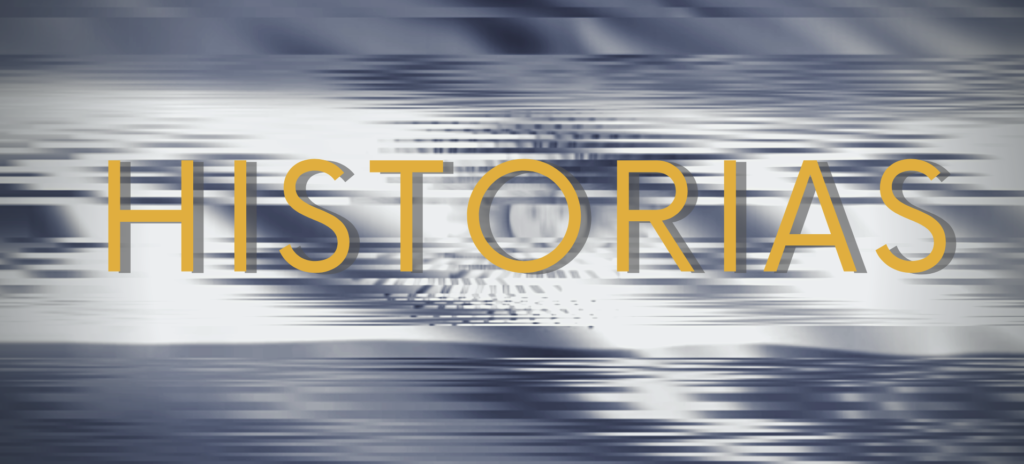
Introducción
Introduction
Esta exposición incluye obras de arte por Bedevo et. al., C.A.PA.TA.CO/GAS-TAR (Fernando Amengual, Mercedes Idoyaga “Emei”, Fernando “Coco” Bedoya, Diego Fontanet, Joan Prim, Carlos N. Tirabassi, y Daniel Sanjurjo), Jaime Davidovich, León Ferrari, Por el Ojo (Julia Balmaceda, Federico Gonzalez, Daniel Sanjurjo, y Ignacio Sourrouille), Liliana Porter, y Dolores Zorreguieta; Ensayos por Ruth Benitez con traducción por Rossy Ramos, Agustina Bullrich con traducción por Rossy Ramos, Fernando Noy con traducción por Agustina Bullrich; Entrevistas por Ruth Benitez con Federico Gonzalez, Liliana Porter, Ignacio Sourouille, y Dolores Zorreguieta.
This exhibition includes artwork by Bedevo et. al., C.A.PA.TA.CO/GAS-TAR (Fernando Amengual, Mercedes Idoyaga “Emei”, Fernando “Coco” Bedoya, Diego Fontanet, Joan Prim, Carlos N. Tirabassi, and Daniel Sanjurjo), Jaime Davidovich, León Ferrari, Por El Ojo (Julia Balmaceda, Federico Gonzalez, Daniel Sanjurjo, and Ignacio Sourrouille), Liliana Porter, and Dolores Zorreguieta; essays by Ruth Benitez with translation by Rossy Ramos, Agustina Bullrich with translation by Rossy Ramos, Fernando Noy with translation by Agustina Bullrich; interviews by Ruth Benitez with Federico Gonzalez, Liliana Porter, Ignacio Sourrouille, and Dolores Zorreguieta.
Declaración Curatorial
Curatorial Statement
Esta exhibición recopila trabajos de multimedia creados entre 1970-2020 por ex alumnos Argentinos de Franklin Furnace. Estos años coinciden con la dictadura militar en Argentina que empezó en 1976, el regreso a la democracia, y la confrontación de los crímenes oscuros cometidos la esta época que causaron gran sufrimiento en la población Argentina y que se verán reflejados en futuras generaciones. Las piezas cuidadosamente seleccionadas para esta exhibición exploran muchos sentimientos, como la solidaridad con países que sufren violaciones contra los derechos humanos, la alienación de la patria, y el deseo de escapar lo convencional. Hístorias fue creada con un formato bilingüe con la idea de hacerla más accesible, incluyendo a públicos que normalmente no tendrían acceso.
This exhibition brings together multi-media works, dating from the late 1970s through 2020, made by Argentine Franklin Furnace alumns. These years coincide with the military dictatorship in Argentina that started in 1976, the return to democracy, and the confrontation of the dark crimes committed during these time period that left the Argentine population aching for generations to come. The curated selection of pieces in this exhibition explore many different sentiments such as solidarity with countries experiencing violations against human rights, disconnects from motherlands, and the desire to escape the mainstream. Hístorias was created with a bilingual format in the spirit of making it more accessible to audiences that normally wouldn’t have been reached.
Historias
Con la intención de repasar ciertos aspectos políticos-sociales de Argentina a finales del siglo XX, Historias examina las obras de varios artistas argentinos que forman parte de la colección de los Archivos de Franklin Furnace. Desde finales de la década de 1970 hasta la actualidad, FF ha establecido relaciones de trabajo y de amistad con decenas de creadores de todo el mundo, entre ellos artistas pertenecientes a la Vanguardia en Argentina.
Estas relaciones han fomentado la concientización y el conocimiento acerca de la dictadura que se apoderó de Argentina durante varias décadas y su dolorosa transición hacia la democracia. Estas experiencias fueron formativas para lo que ha llegado a ser parte de la identidad de la comunidad argentina, y a pesar de que las experiencias fueron muy diferentes para cada individuo, existe un sentido unificador de afecto por la Patria (madre patria) que puede verse como la fuente primaria de motivación para muchos de estos artistas. Esto era cierto incluso si el artista ya no estaba en Argentina y de hecho se sentía alejado de su país. Es cierto para los artistas que optaron por no hacer piezas que sean explícitamente sobre Argentina, y sigue siendo cierto incluso en obras de arte que lanzan duras críticas políticas al gobierno argentino y a instituciones poderosas como la Iglesia Católica.
A primera vista, los artistas de esta muestra parecen no tener mucho en común. Utilizan medios de expresión diferentes, abordan temas distintos y algunas de sus obras están separadas por varias décadas. Sus diferencias se deben a las experiencias individuales que vivieron durante la dictadura y la difícil reconstrucción de un gobierno democrático. Si bien algunos artistas ya no estaban en Argentina cuando el golpe de estado militar de 1976 infundió un estado de terror en el país, otros crecieron en familias que apoyaban a los militares. Muchos sintieron de primera mano las violaciones a los derechos humanos cuando sus propios familiares se convirtieron en desaparecidos, el nombre que se le dio a aquellos individuos a quienes los militares hicieron “desaparecer”; es decir, torturar y luego matar a miles de víctimas por razones políticas. La compleja historia que condujo a estas experiencias tan diferentes dentro de la comunidad argentina es el telón de fondo contra el cual Historias presenta reacciones artísticas políticamente cargadas sobre esta época oscura de Argentina junto con las que en su mayoría permanecieron en las periferias de este contexto histórico.
En 1975, el artista Jaime Davidovich se encontraba viviendo en Nueva York. Este artista reflexionaba sobre la situación en la que se había convertido Argentina, su madre patria, si bien no en relación con la dictadura, sino en referencia con los cambios que se estaban produciendo en si mismo, tema que explora en La Patria Vacía (Empty Homeland), en donde Davidovich aborda los sentimientos de alienación de su país. Al mismo tiempo, entraba a formar parte de un grupo revolucionario de artistas neoyorquinos que cambiaría lo que se entiende por televisión, re-ordenando la continuidad del arte en sí. Veinte años más tarde, Por El Ojo, el colectivo de artistas formado por Julia Balmaceda, Federico González, Daniel Sanjurjo e Ignacio Sourrouille, seguiría jugando con la misma idea al realizar Video Sin Cámara (Video Without Camara).
Fue en la década de 1980 cuando Franklin Furnace entró en contacto con León Ferrari, un artista que se vio obligado a exiliarse en 1976 a causa de la dictadura, e incluso perdió un hijo a manos del gobierno argentino, después de haber sido secuestrado y posteriormente asesinado. El Sr. Ferrari es conocido por sus críticas agudas, a menudo envueltas en un humor conmovedor. Estas cualidades se evidencian claramente en los collages y postales elegidos para esta exhibición. Aunque estas obras visuales comentan de manera más general cómo la Iglesia Católica tiende a apoyar la violencia y a convertir la fe en un arma, Ferrari nunca dejó de mantener a Argentina y su liderazgo en sus altos estándares.
Mientras que Leon Ferrari trabajaba en estas piezas, Emei y Fernando “Coco” Bedoya trabajaban con varios artistas en Argentina para hacer carteles para eventos o para hacer declaraciones políticas. Todos ellos realizados una vez iniciada la transición a la democracia, después de 1983, y de los cuales Bedoya donó 38 piezas en un portafolio amablemente a Franklin Furnace en 1991. Estos carteles nos permiten vislumbrar algunas de las ideas difundidas por Bedoya, Carlos Tirabassi y colectivos de artistas como Gas-tar, C.A.PA.TA.CO y Por El Ojo. Más allá de las manifestaciones públicas de disconformidad, se trata de llamamientos a la acción, a la solidaridad con la población argentina y con los pueblos del mundo que también sufren el incumplimiento de los derechos humanos. Paralelamente, los artistas se unieron para crear algo que no se limitara a utilizar un solo medio artístico. El Sr. Bedoya reunió a músicos, artistas plásticos, intérpretes y otras figuras para crear el Museos Bailables. Lo único que tenemos ahora de estos efímeros eventos son los carteles y las mariposas, unos pequeños trozos de papel lanzados al aire desde vehículos en movimiento que al caer parecían mariposas encargadas de dar el anuncio, así como el recuerdo de las personas que pudieron formar parte de estos encuentros.
Las obras dentro del portafolio de Bedoya fueron las semillas de las que se desarrolló Historias, una exposición que se expande más allá de este portafolio para investigar el trabajo que Por el Ojo siguió haciendo, así como el de otros argentinos que trabajaron con Franklin Furnace. El programa de televisión de acceso público de Jaime Davidovich, por ejemplo, parece estar relacionado con los televisores de graffiti de Por el Ojo pocos años después. Sin embargo, esta conexión es en gran parte una coincidencia que se produjo porque Por el Ojo simplemente no podía pagar una cámara de video; en su lugar, empezaron a reinventar objetos cotidianos como pantallas y usar grafitis para “televisar” mensajes que no se transmitían al público. Mientras que el Sr. Davidovich pudo infiltrarse en la corriente principal de la ciudad de Nueva York con su programa de televisión por cable Live! Show, Por el Ojo solucionó su falta de acceso al medio de transmisión difundiendo sus mensajes con pinturas en aerosol de guerrilla. Aunque adoptaron enfoques muy diferentes, el Sr. Davidovich y la Sra. Balmaceda, el Sr. González, el Sr. Sanjurjo y el Sr. Sourouille de Por el Ojo tuvieron gran éxito en sus esfuerzos por evitar la censura y adoptar la omnipresencia de la televisión en su arte.
En Ficciones, un libro de artista realizado exclusivamente para Hístorias, Liliana Porter revisita Ficciones, una colección de cuentos escritos por Jorge Luis Borges. El inteligente trabajo de la Sra. Porter centra la atención en la palabra espejo y su significado en el trabajo de Borges. En los escritos de Borges, los espejos a menudo se representan como portales multifuncionales y se utilizan de manera que recuerdan el arte visual del Sr. Davidovich, quien afirmó que los espejos también eran televisores.
En la serie escultural Wounds (Heridas), de Dolores Zorreguieta, que se publicó en 1994, se abordan de forma contundente las cicatrices físicas y psicológicas dejadas por la dictadura, lo que nos remite a las brutales realidades que vivieron estos artistas. Si bien muchos de los artistas pudieron crear espacios que cultivaron un trabajo de forma explícita, la Sra. Zorreguieta es una de las artistas que nos golpea con la brutal experiencia de la historia de Argentina. Del mismo modo, el Sr. Ferrari no ocultó nada en los collages que realizó para su exposición en el Franklin Furnace en 1987, fue alguien que expresó en su obra sentimientos antibélicos, pero también la hipocresía de la participación de la iglesia en actos contra la humanidad no sólo en Argentina, sino también en todo el mundo y en lugares como Alemania.
A pesar de compartir su patria, los artistas visuales que aparecen en Historias son personas con sensibilidades políticas y estéticas únicas. Porque comparten el peso de la historia de Argentina, por muy cercano o lejano que sea su contacto con ella, todos cargan con el peso de Argentina. Es ese peso lo que les dio la fuerza para forjar este considerable cuerpo de arte, a la vez ruidoso, movilizador, elocuente y siempre relevante para el pasado, presente y futuro de la humanidad.
Expresiones de Gratitud
Me gustaría tomarme el tiempo para agradecer a todos los que ayudaron a hacer de Historias una realidad. Fatima Bercht tuvo la amabilidad de compartir su ojo entrenado para asegurarse de que viera muchos detalles en las obras de arte seleccionadas. Agustina Bullrich siempre estaba dispuesta a verificar los hechos y fundamentar mis ideas cuando flotaban demasiado lejos. Rossy Ramos brindó una guianza inquebrantable durante todo el proceso. Judith Henry ofreció información muy útil sobre el trabajo de Jaime Davidovich, y estamos agradecidos a Mercedes Cohen e ISLAA, el Instituto para el Estudio del Arte Latinoamericano, así como a Brian Bentley de la Fundación Jaime Davidovich y a Karl McCool de Electronic Art Intermix por su apoyo a lo largo de los procesos de planificación. Arantxa Araujo, Sherry Tseng y Yoon Cho, quienes trabajaron arduamente para hacer posible esta primera exhibición de arte visual en línea de Franklin Furnace. Gracias a Yayoi Tanimoto por el trabajo que hizo para organizar y recopilar la información de las piezas del portafolio de Bedoya, y a Joey Ball, Marcus Chan y Patrick Li por sus esfuerzos preparatorios. Harley Spiller tuvo la fe de confiarme este proyecto, mi primera vez como curadora y le envío un gran agradecimiento a él y a Franklin Furnace Archive por mantenerse fiel a la promesa de brindar una pasantía iluminante. Finalmente, mi agradecimiento a CUNY Cultural Corps por asociarme con Franklin Furnace Archive y brindar a muchos otros estudiantes oportunidades similares.
Ruth Benítez, Curadora
Marzo 2021
To glimpse the history of Argentina in the later half of the 20th century, Historias takes a closer look at the works of the Argentine artists who have become Franklin Furnace alumns. From the later half of the 1970s until the present, Franklin Furnace has built working relationships and friendships with legions of artists from around the globe, including many avant-garde artists from Argentina.
These relationships have fostered hyper-awareness of the dictatorship that had gripped Argentina for so long, as well as the painful transition back to democracy. These experiences were formative for what has come to be part of the Argentine community identity, and despite the very different experiences that each individual could have, there is a unifying sense of affection for their Patria (mother country) that can be seen as a primary motivation for many of these artists. This was true even if the artist was no longer in Argentina and in fact felt alienated from their country. It holds true for artists who chose to not make pieces that are explicitly about Argentina, and remains true even in art works which throw tough political criticism at the Argentine government and powerful institutions such as the Catholic Church.
At first glance many of the Historias artists might not seem to have much in common. They use different mediums, address different themes, and some of their work is separated by multiple decades. These differences stem from unique individual experiences with the dictatorship and the difficult reconstruction of a democratic government. While some artists were no longer in Argentina when the military coup d’etat of 1976 instilled a state of terror in the country, others grew up in families which supported the military. Many felt firsthand the violations of human rights when their own family members became desaparecidos, the name given to those individuals whom the military made “disappear;” i.e., torturing and then killing thousands of victims for political reasons. The complex history that led to these vastly different experiences within the Argentine community is the backdrop against which Historias presents politically charged artistic reactions to this dark period in Argentina, alongside those which mostly remained in the peripheries of this historical context.
In 1975 artist Jaime Davidovich was in New York City reflecting on what his Argentine homeland had become, not in relation to the dictatorship quite yet, but on what the changes represented within himself. Mr. Davidovich’s La Patria Vacia (Empty Homeland) addresses his feelings of alienation from his country of origin. At the same time he was becoming part of a revolutionary group of New York artists which would change what is understood to be television, reordering the continuity of art itself. Less than twenty years later, Por El Ojo, the artist collective formed by Julia Balmaceda, Federico Gonzalez, Daniel Sanjurjo, and Ignacio Sourrouille, would also address the theme of television with their project Video Sin Cámara (Video Without Camera).
It was in the 1980s when Franklin Furnace came into contact with León Ferrari, an artist who was forced into exile in 1976 because of the dictatorship and ultimately lost a child to the Argentine government which kidnapped and then killed his son. Mr. Ferrari is known for sharp critique often cloaked in poignant humor. These qualities are clearly in evidence in the collages and the postcards chosen for this show. Although these visual works comment more generally on how the Catholic Church tends to support violence and weaponize faith, Ferrari never failed to hold Argentina and its leadership to his high standards.
Around the same time Mr. Ferrari was making these collages and multiples, once the transition into democracy had already begun after 1983, Emei and Fernando “Coco”
Bedoya were working with a variety of artists in Buenos Aires to help them produce political statements and posters for events. In 1991 Bedoya kindly donated a portfolio of 38 such works to Franklin Furnace. These printed multiples represent some of the potent ideas being spread at the time by the Bedoyas, Carlos Tirabassi, and artists’ collectives like Gas-tar, C.A.PA.TA.CO. and Por El Ojo. They are not simply public displays of dissent but calls to action and calls for solidarity among the Argentine population, as well as with others around the world suffering from a lack of human rights. Concurrently, there were other Argentine artists in Mr. Bedoya’s circle, like Fernando Noy, interested in creating work that was not restricted to a single artistic medium, so Mr. Bedoya brought together musicians, visual artists, performers and more to create a multidisciplinary group they called Museos Bailables (Museums of Dance). The only thing left to art history from these elusive events are the participants themselves, posters and mariposas, small pieces of paper which were thrown into the air, often from moving vehicles. Named because they resemble butterflies as they flutter in the air and fall to the ground announcing charged messages, these simple little flyers can stir potent memories.
The works within the Bedoya portfolio were the seeds from which developed Historias, an exhibition which expands beyond the portfolio to investigate work Por el Ojo continued to do, as well as that of other Argentines who worked with Franklin Furnace. Jaime Davidovich’s public access television show for example, seems related to Por el Ojo’s graffiti televisions just a few years later. This connection is, however, largely a coincidence that came about because Por El Ojo was simply not able to afford a video camera – in its stead they took to reimagining everyday objects as screens and using graffiti to “televise” messages not being broadcast to the mainstream. Whereas Mr. Davidovich was able to infiltrate the mainstream in New York City with his long-running cable television Live! Show, Por el Ojo worked around their lack of access to the broadcast medium by spreading their messages with guerilla spray paintings. Although they took vastly different approaches, Mr. Davidovich and Por el Ojo’s Ms. Balmaceda, Mr. Gonzalez, Mr. Sanjurjo and Mr. Sourouille were largely successful in their efforts to avoid censorship and embrace television’s omnipresence in their art.
In Ficciones, an artists’ book made exclusively for Hístorias, Liliana Porter revisits Ficciones, a collection of short stories written by Jorge Luis Borges. Ms. Porter’s smart work focuses attention on the word espejo (mirror) and its significance in Borges’ work. In Borges’ writings, mirrors are often depicted as multi-functional portals and used in ways recalling the visual art of Mr. Davidovich, who claimed mirrors were also televisions.
Dolores Zorreguieta’s Wounds, a sculptural series from 1994, bluntly addresses the physical and psychological wounds left behind from the dictatorship, and forces sentient viewers to confront the brutal realities that these artists experienced. Although many of the artists in Historias were able to create safe spaces in which to cultivate their explicit work, Ms. Zorreguieta’s work unmercifully portrays the brutal reality of Argentina’s history. Similarly, Mr. Ferrari hid nothing of his clear anti-war sentiments in the collages made for his 1987 Heretic Chapel installation at Franklin Furnace, which also address the hypocrisy of the Church’s involvement in acts against humanity, not only in Argentina but in Germany and around the world.
Despite sharing their patria, the visual artists featured in Historias are individuals with unique aesthetic and political sensibilities. Because they share the weight of Argentina’s history, regardless of how close or distant their contact with it was and is, they all carry the weight of Argentina. It is that weight which gave them the strength to forge this considerable body of art, at once loud, mobilizing, eloquent, and ever-relevant to humankind’s past, present and future.
Acknowledgments
I’d like to take the time to thank everyone that helped make Historias a reality. Fatima Bercht was kind enough to share her trained eye to make sure I saw many details in the artworks selected. Agustina Bullrich was always ready to fact check and ground my ideas when they floated too far away. Rossy Ramos provided unwavering guidance throughout the process. Judith Henry offered very helpful insights into the work of Jaime Davidovich, and we are thankful to Mercedes Cohen and ISLAA, the Institute for the Study of Latin American Art, as well Brian Bentley at the Jaime Davidovich Foundation, and Electronic Art Intermix’s Karl McCool for their support throughout the planning processes. Arantxa Araujo, Sherry Tseng and Yoon Cho who all worked hard to make this first-ever Franklin Furnace online visual art exhibition possible. Thanks to Yayoi Tanimoto for the work she did to organize and collect the information for the pieces in the Bedoya portfolio, and Joey Ball, Marcus Chan, and Patrick Li for their preparatory efforts. Harley Spiller had the faith to entrust me with this project, my first time as a curator and I send big thanks to him and Franklin Furnace Archive for keeping true to the promise of providing a meaningful internship. Finally, my thanks go to CUNY Cultural Corps for pairing me with Franklin Furnace Archive and providing many other students with similar opportunities.
Ruth Benítez, Curator
March 2021
León Ferrari

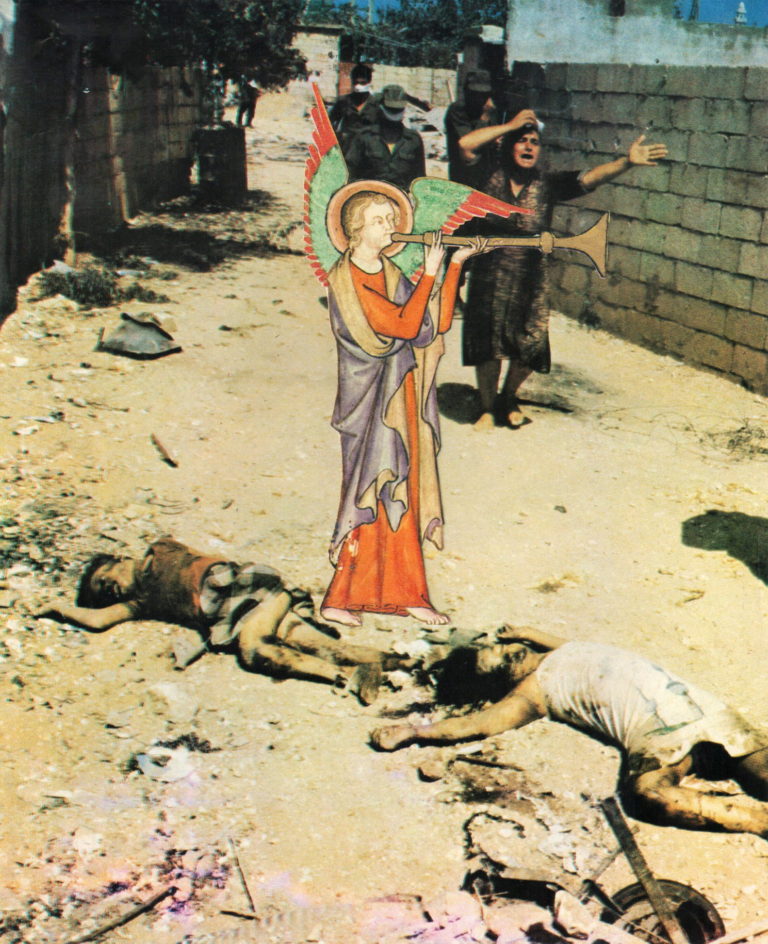
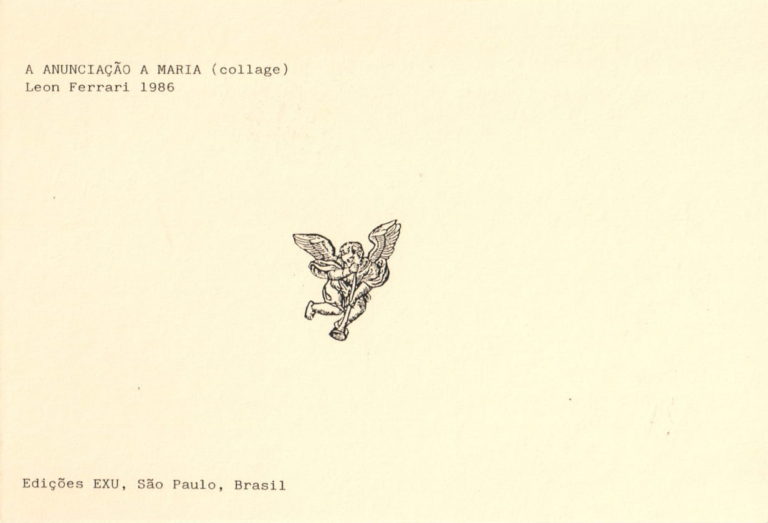
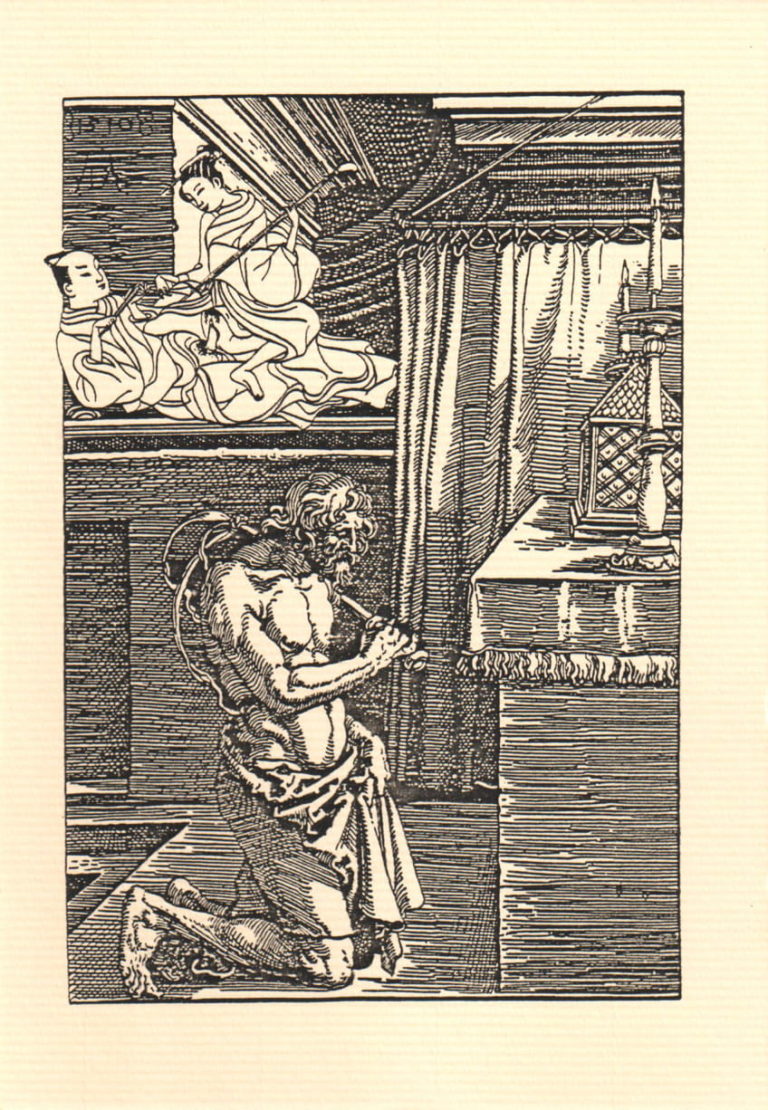
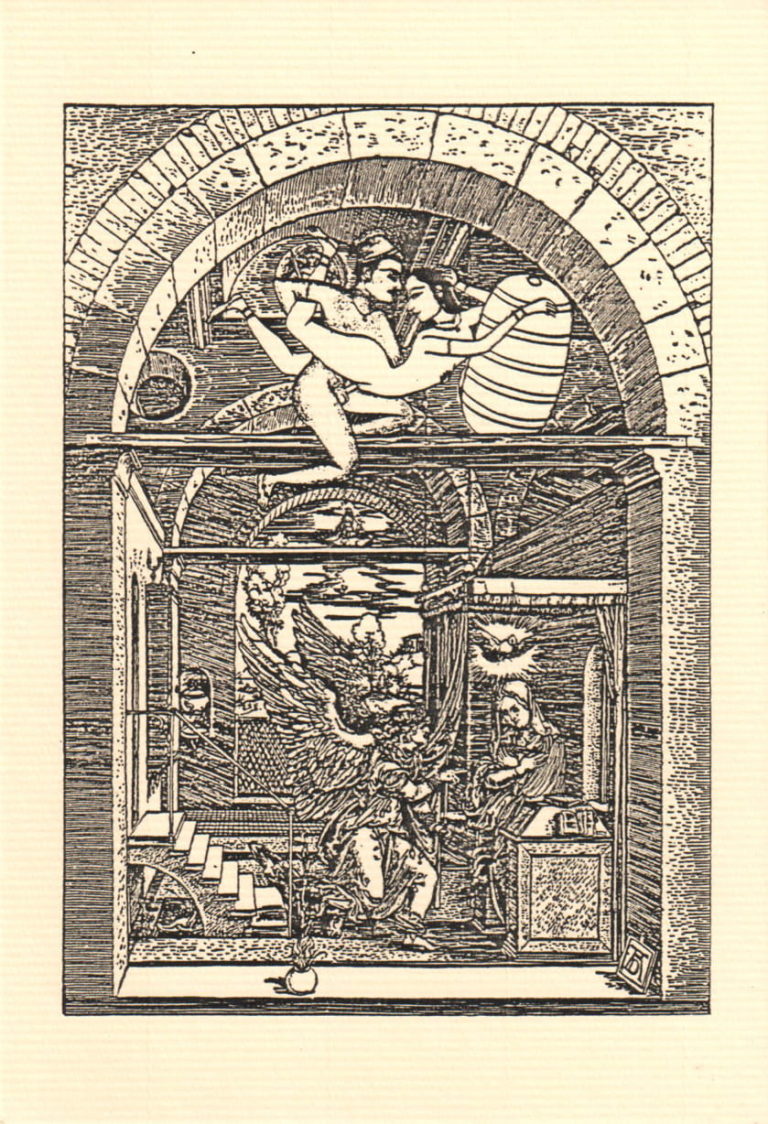
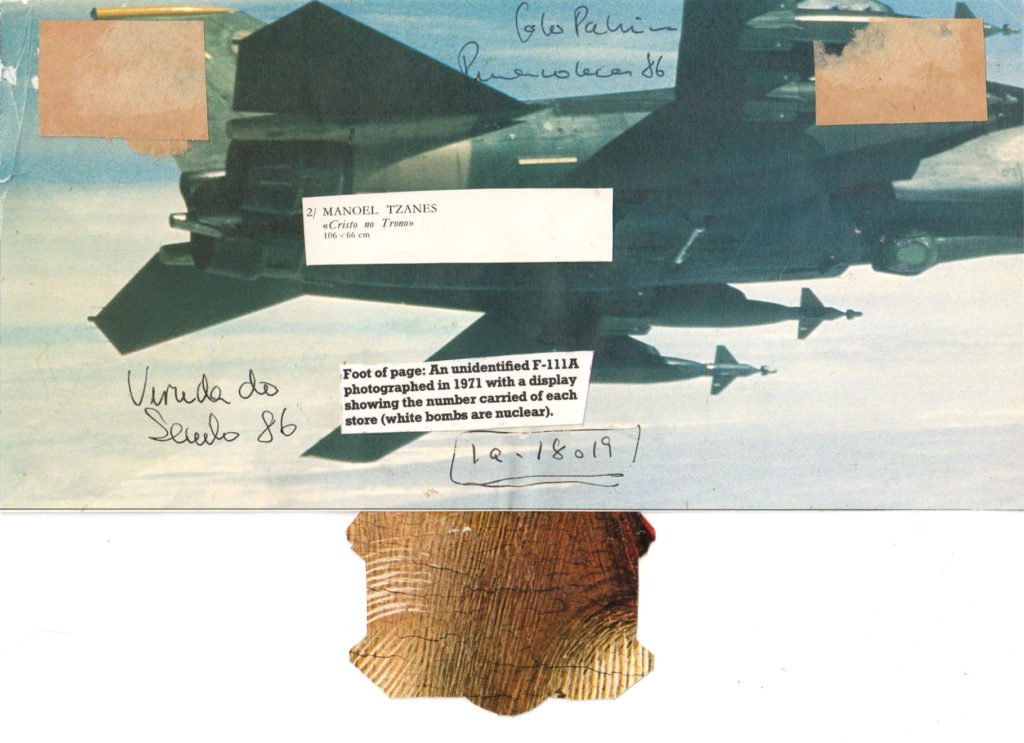


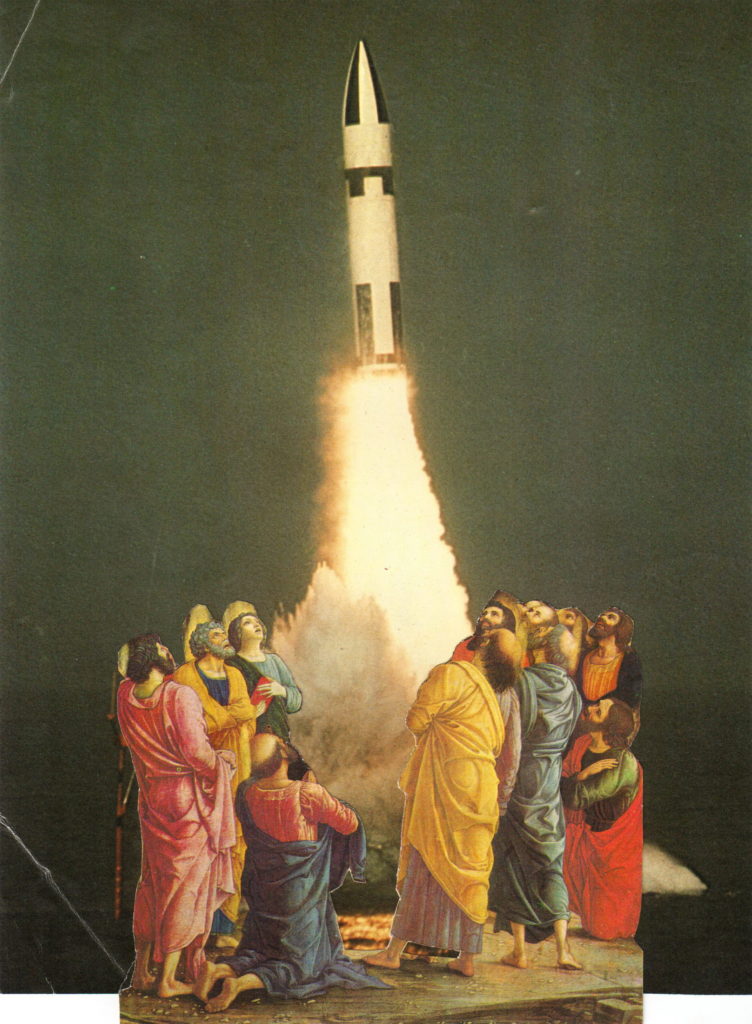
Cicatriz
Cicatriz por Agustina Bullrich
Traducción por Rossy Ramos
La democracia tenía la forma de la multitud: Un organismo de varias cabezas, con las capacidades de saltar, cantar y sudar, todo al mismo tiempo, en el mismo espacio. La democracia, para mi, era fricción y alegría. Desconocía que no siempre había sido así, que después de la dictadura militar más brutal de nuestra historia, la democracia se sentía como una bendición en lugar de ser el estado implícito de una sociedad libre.
Recuerdo que sentada en los hombros de mi padre -a caballito-, tenía una vista envidiable, desde allí divisaba un mar de cabezas, y desde lejos podía ver a un hombre que desde un balcón, se dirigía hacia la multitud. Pude reconocerlo, era el presidente de nuestro país. Era Abril de 1987 y yo tenía cinco años. Para ese entonces llevábamos ejerciendo la democracia alrededor de tres años, gobernaba el Presidente Raúl Alfonsín, el cual sentó un precedente histórico en Latinoamérica y el mundo, cuando en 1985 firmó un decreto ordenando el juicio de las Juntas Militares.
No pasó mucho tiempo cuando se hizo evidente que la democracia que habíamos recuperado aún era frágil. Las juntas militares todavía tenían mucho poder y, entre múltiples demandas, estaban ejerciendo una presión considerable sobre el gobierno para que pusiera fin a los juicios por las violaciones a los derechos humanos. Cuando se produjo el primer levantamiento militar –de varios que siguieron– y se dibujó en el horizonte la amenaza de un nuevo golpe de Estado, el pueblo argentino inundó las calles. Y eso es lo que estábamos haciendo ese día en la Plaza de Mayo: defendíamos la democracia.
Al salir de la manifestación, recuerdo llevarme conmigo la adrenalina de la multitud que saltaba. En el viaje de regreso a casa, seguí cantando lo que había escuchado en la Plaza: Hay que saltar, hay que saltar, el que no salta es militar. Mientras nos acercabamos a nuestra casa, mamá dijo – Ahora, cuando lleguemos, deja de cantar, ¿de acuerdo?
¿Por qué? – Pregunté, provocando una respuesta que no tenía mucho sentido para mí en ese momento. – No sabemos quiénes son los vecinos – fueron las palabras pronunciadas por mi madre. Y supongo que también trató de explicar algo de una manera que una niña de cinco años pudiera entender, algo acerca de que los vecinos tal vez tengan una opinión diferente de los militares o incluso que tengan parientes militares, pero yo no entendí mucho de todos modos. Nosotros conocíamos a los vecinos, sabíamos sus nombres, sabíamos que mi hermano y yo jugábamos largas horas con sus hijos. Entonces, razoné, sabíamos quiénes eran.
No fue hasta mucho más tarde que pude entender el comportamiento defensivo de mi madre. Se necesita más –mucho más– que un cambio de gobierno para que los cuerpos liberen el miedo, para que las personas puedan volver a confiar entre sí, para que la piel de la sociedad cicatrice.
Cicatriz by Agustina Bullrich
Original text
Democracy to me had the shape of the multitude: a multi-headed organism that jumped and sang and sweat, all at the same time, in the same space. Democracy was friction and joy. I didn’t know it hadn’t always been like this, didn’t understand that after the most brutal military dictatorship in our history, democracy felt like a blessing instead of the natural state of society. I had a privileged vantage point, sitting on my father’s shoulders –a caballito– I could gaze upon a sea of heads and far far away there was a man speaking to the crowd from a balcony. He was our President, that I knew.
It was April of 1987 and I was five years old. We had been exercising democracy for a little more than three years, and although just three days after President Raúl Alfonsín took office, he signed the decree ordering the trial of the Military Juntas –which would take place in 1985 setting a historical precedent for the Latin American region and for the world– it soon became evident that our regained democracy was a fragile thing. The militaries still held a lot of power and, among other demands, they were putting considerable pressure on the government to end the trials for human rights violations. When the first military uprising –of several to follow– took place and the threat of a new coup d’état was drawn on the horizon, the Argentine people flooded the streets. And that’s what we were doing that day at Plaza de Mayo: We were standing up for democracy.
As we left the demonstration, I remember taking with me the adrenaline of the jumping crowd. On the trip back home, I kept singing the chant I had heard at the Plaza: Hay que saltar, hay que saltar, el que no salta es militar (You have to jump, you have to jump, if you don’t jump you are pro-military). As we were approaching our house, Mom said:
“Now when we get there, you stop singing, OK?”
“Why?” I asked, prompting an answer that didn’t make much sense to me at the time.
“We don’t know who the neighbors are,” were the words pronounced by my mother. And I guess she also tried to explain something in a way that a five year-old could understand –something about the neighbors maybe having a different opinion of the military or even having military relatives– but I didn’t understand much anyways. We knew the neighbors, we knew their names, we knew that my brother and I played long hours with their kids. Then, I reasoned, we knew who they were.
It wasn’t until much later that I could make sense of my mom’s defensive behavior. It takes longer –much longer– than a change of government for bodies to release fear, for people to be able to trust each other again, for society’s skin to scar over.
Political Posters
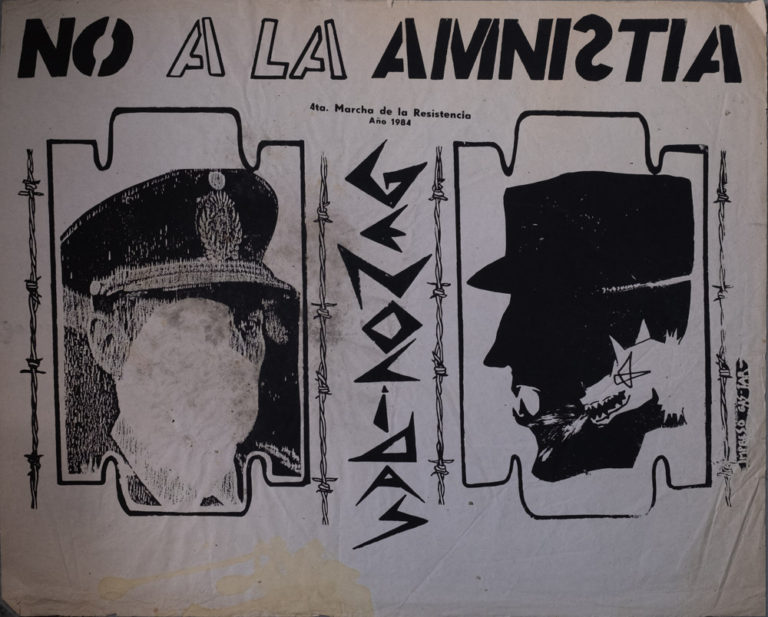
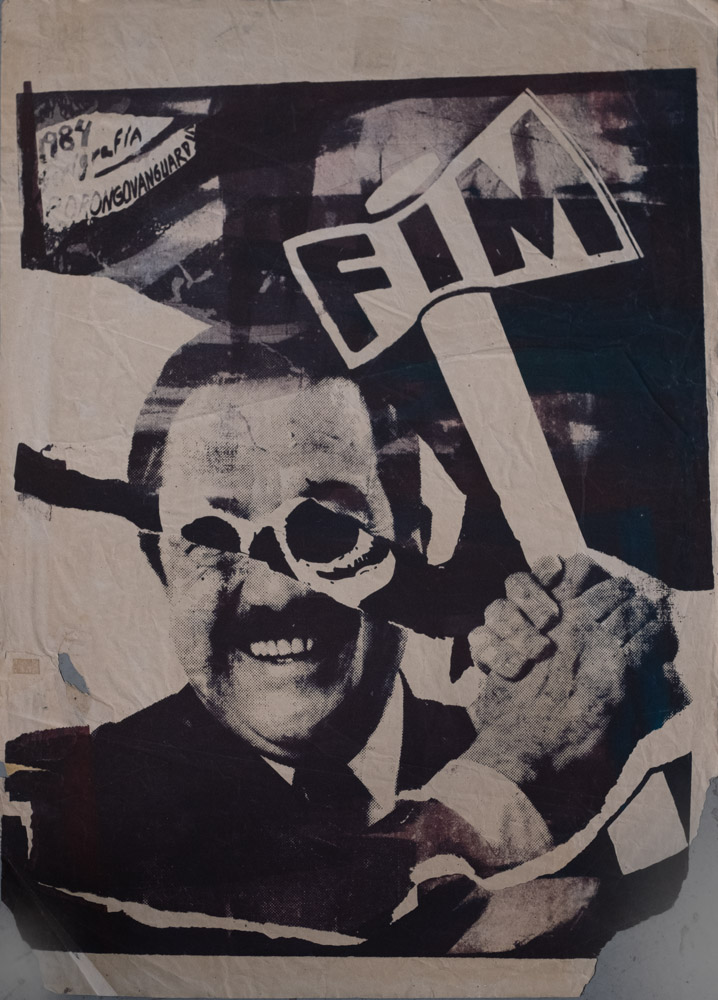
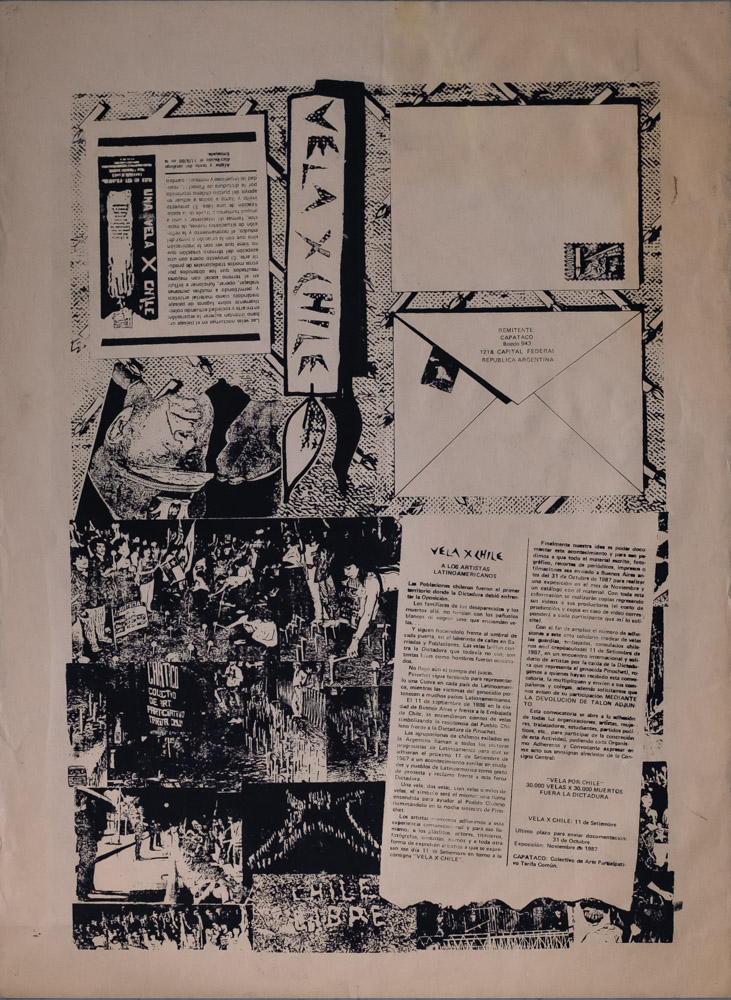
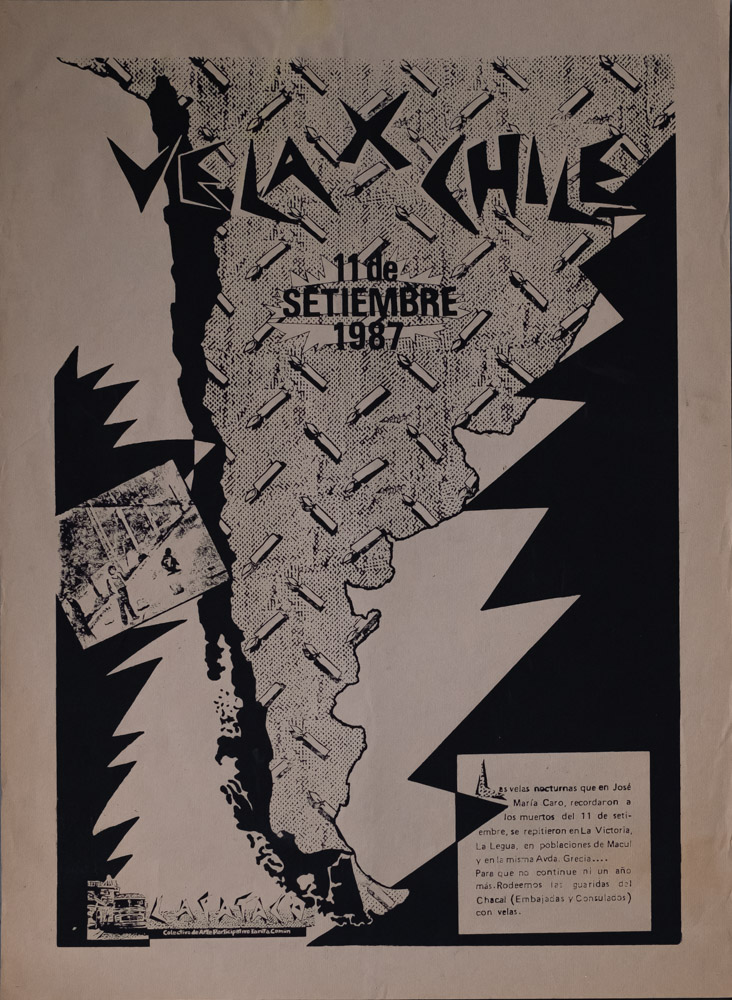
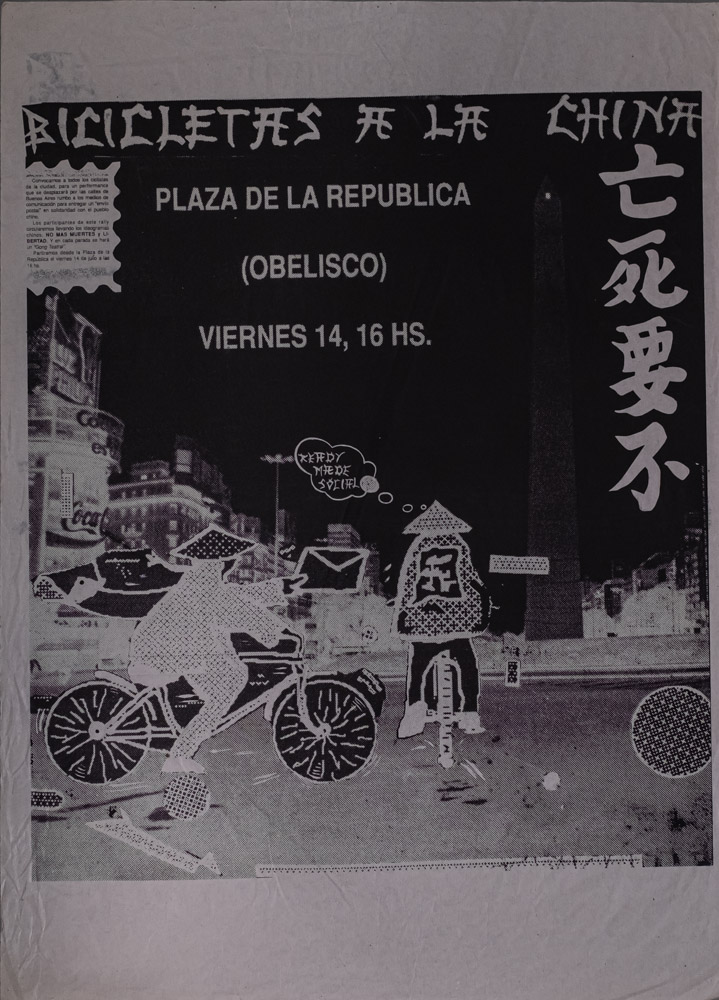
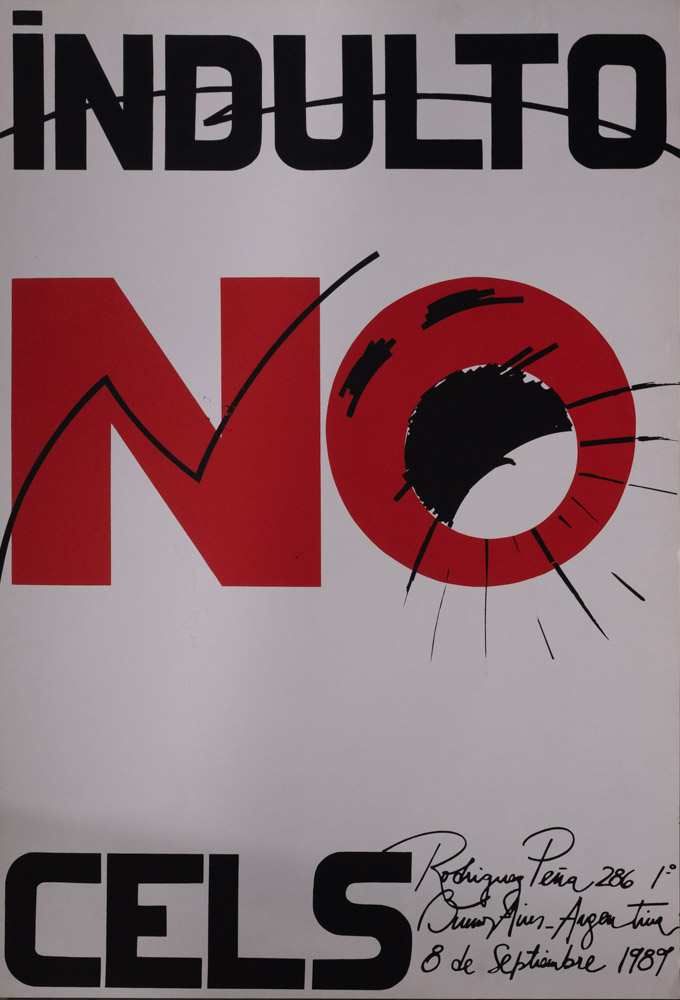
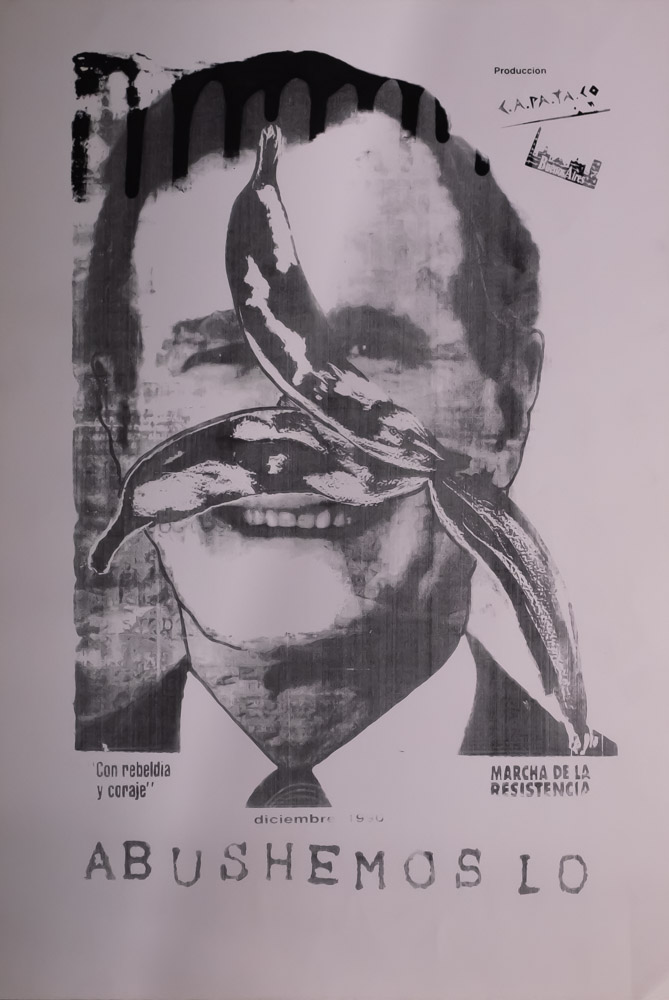
Museos Bailables
Por Fernando Noy
Texto Original
Evocar los museos bailables que desde Cemento a Mediomundo Varieté tuve la dicha de conformar me recupera el placer de haberlo compartido.
Especialmente por Fernando Bedoya, uno de esos artistas capaces de revolucionar superando slogans, como el mismo decía, “desaprendiendo” para dejar vacío el espacio mental y volver a colmarlo de una nueva y futura zafra creativa ya sin subordinaciones de ninguna estética, aunque podrían emparentarse, de algún modo, estos museos vivientes y danzantes con el Cabaret Dada o los safaris surrealistas (más artaudianos que de André Breton).
Como el safari antropofágico del modernismo que Oswald de Andrade postulara con sus pares en la semana de arte moderna paulistana, por siempre novedosa de sus manifiestos donde también surgen otros nuevos y conmovedores horizontes coincidiendo fuera de un tiempo histórico al margen pero con vida propia imposible de soslayar, también “museo bailable” fueron noches luminosas que gestaron, al margen de lo histórico lineal. Un mundo amalgamado como utópica patria sin fronteras en un tiempo propio sin cronologías previsibles.
Bedoya convocaba a sus pares y después surgían esos chamanísimos instantes de pleno placer total donde se entremezclaban las nuevas musas desvariadas y poseídas por sus seguidores que sacaban la momia sepulcral del museo vampiro para darle una vida nueva e infinita que hasta hoy siguen por siempre inolvidables como un sueño hiperreal.
La singular capacidad de anti líder que Bedoya desplegaba con gran poder junto a sus conjurados aporta o mejor dicho ofrenda estos museos bailables hasta ahora incomparables como también ajenos a la fatídica marca de marketing y toda su mafia tan evidente dentro de la habitualmente “reconocida” creatividad.
En este caso, fundamentalmente ajenos al siempre presente mainstream tan banal como oficial y por lo tanto, aún más valioso dentro de un anti-estilo magnético, profano y al mismo tiempo puramente creativo, lúdico y devocional.
Con luz tan propia que primero pareciera enceguecer y al fin revela el placer de un verdadero arte encarnado sin subordinaciones, con la más salvaje belleza en su poética total
By Fernando Noy
Translation by Agustina Bullrich
I had the joy of being part of the Danceable Museums (Museos bailables) from Cemento to Mediomundo Varieté. Evoking them brings me back the pleasure of having shared them.
Especially because of Fernando Bedoya, one of those artists with the ability to revolutionize by overcoming slogans, or as he himself used to say by “unlearning” in order to empty the mental space and fill it back in with a new and future creative harvest which is no longer subject to any aesthetic, although we could somehow trace a link between these living and danceable museums and the Dada Cabaret or the surrealist safaris (closer to Artaud than to Breton).
Like the anthropophagic modernist safari that Oswald de Andrade had postulated with his peers in the São Paulo modern art week -forever original in its manifestos- where other new and touching horizons also emerge coinciding on the margin, outside a historical timeline, but with a life of its own that’s impossible to ignore. Danceable Museums were bright nights that also brewed up on the margin of linear history. An amalgamated world as a utopian homeland without borders in a time of its own and without foreseeable chronologies.
Bedoya would bring together his peers and then those hyper-shamanic moments of full total pleasure would arise, where the new raving muses possessed by their followers would intermingle, taking the sepulchral mummy out of the vampire museum to give it a new and infinite life that remains, until today, forever unforgettable as a hyper-real dream.
The singular anti-leader ability displayed by Bedoya with great power in tandem with those he called upon, present these danceable museums as an offering so far incomparable as well as alien to the fateful marketing mark and all its mafia so evident within the usually “recognized” creativity.
The Danceable Museums were fundamentally alien to the ever-present shallow and official mainstream and therefore, even more valuable within a magnetic, profane and at the same time purely creative, playful and devotional anti-style. With such a unique light that it first seems to blind and finally reveals the pleasure of a true art incarnated without subordination, with the wildest beauty in its total poetics.
The Danceable Museums were fundamentally alien to the ever-present shallow and official mainstream and therefore, even more valuable within a magnetic, profane and at the same time purely creative, playful and devotional anti-style. With such a unique light that it first seems to blind and finally reveals the pleasure of a true art incarnated without subordination, with the wildest beauty in its total poetics.
Event Prints
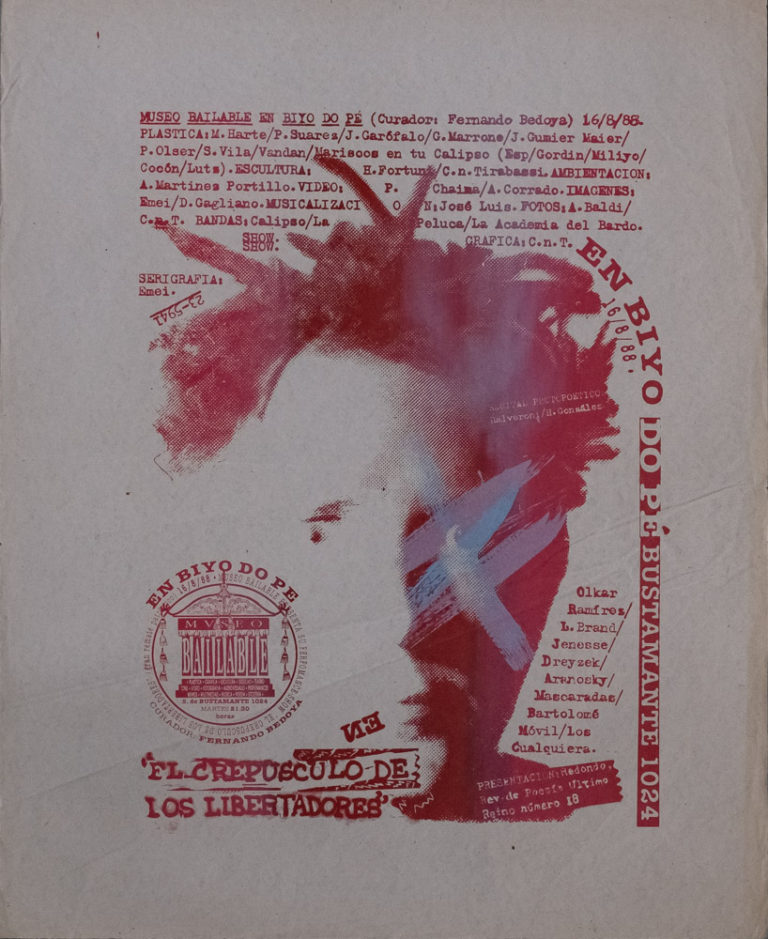
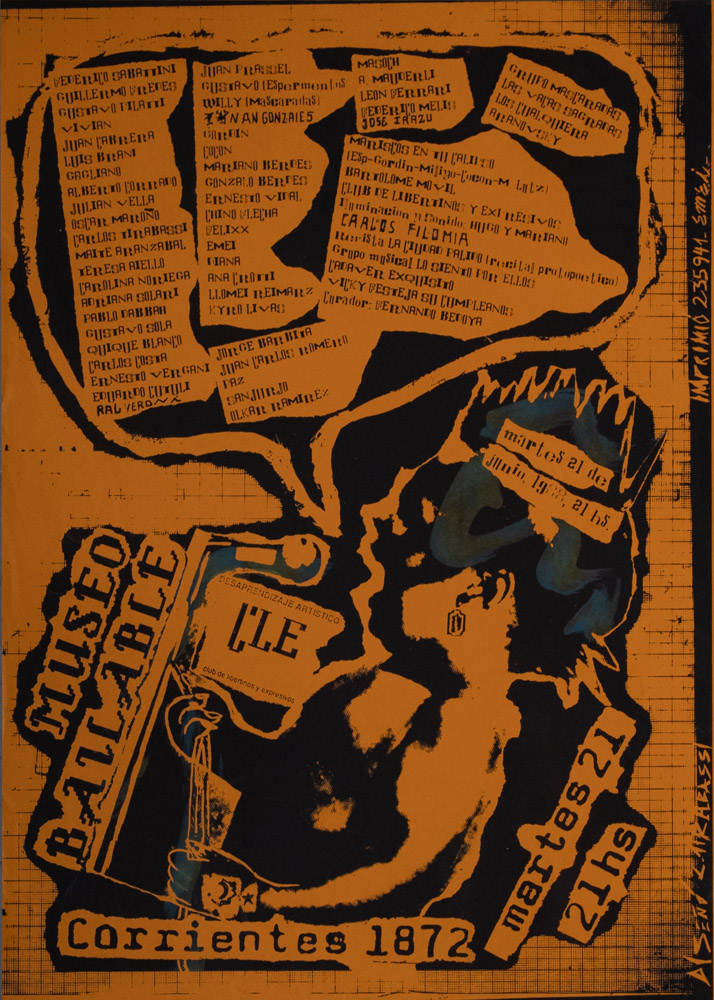
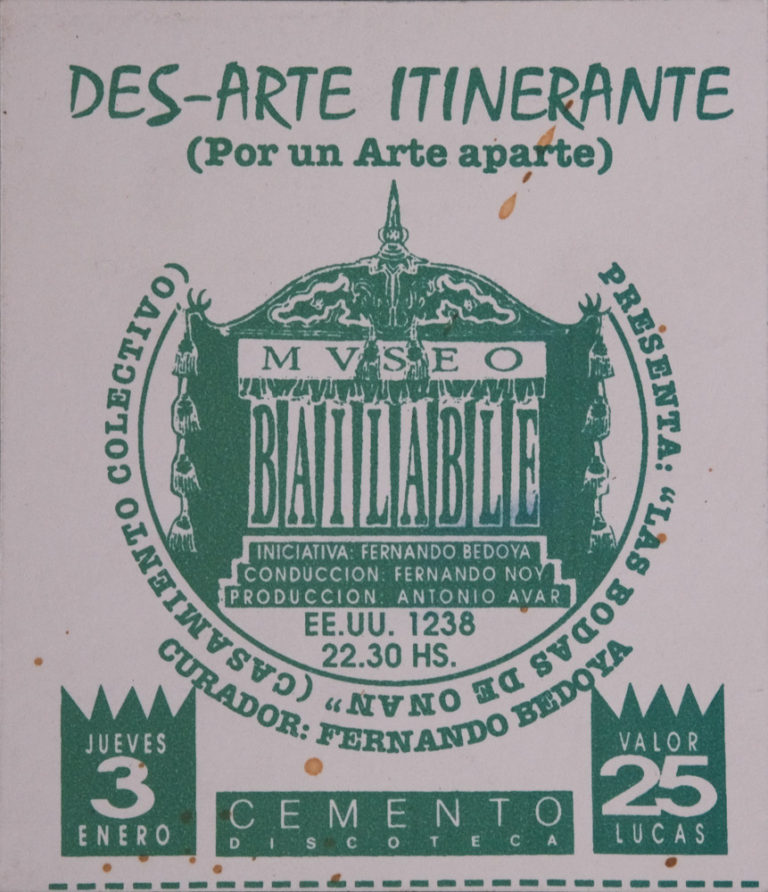
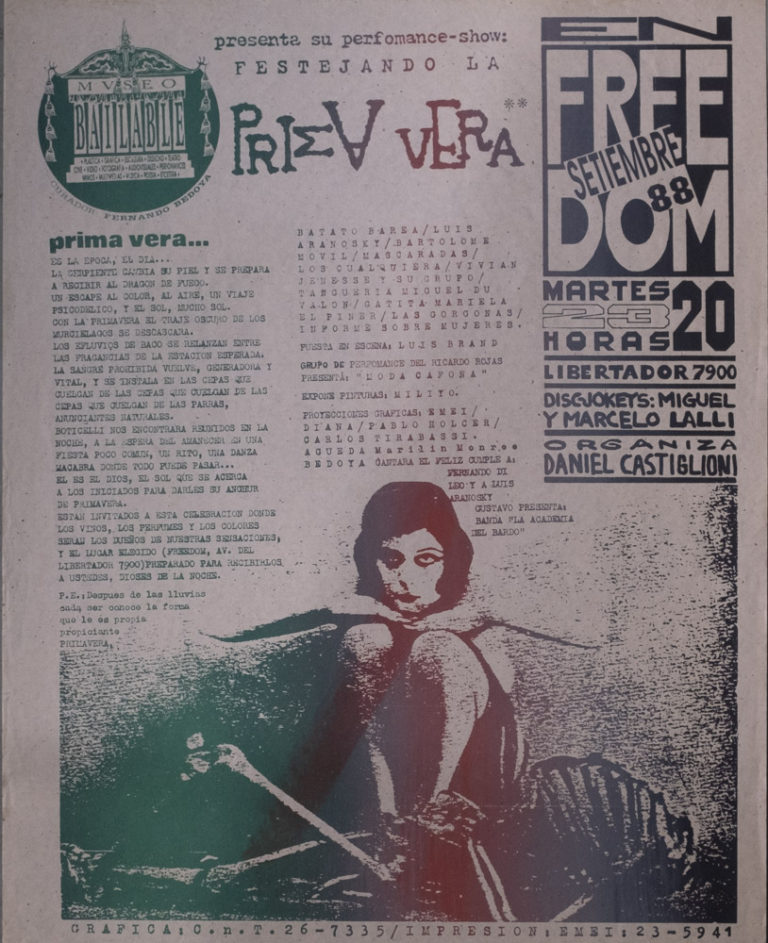
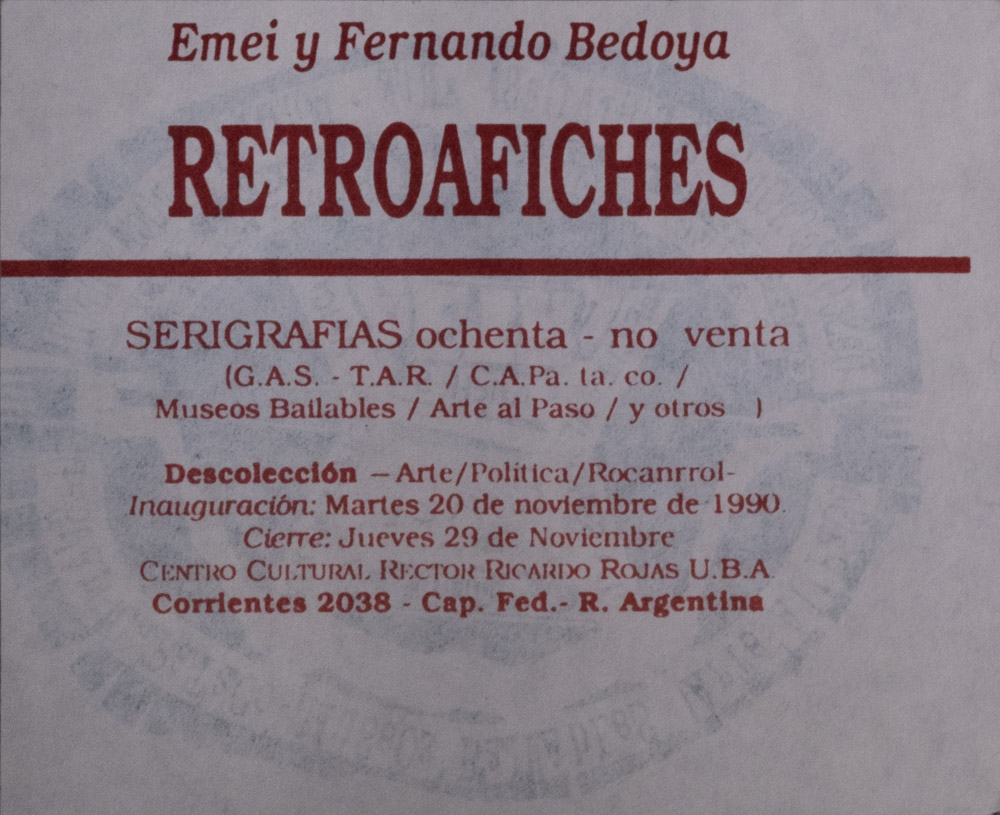

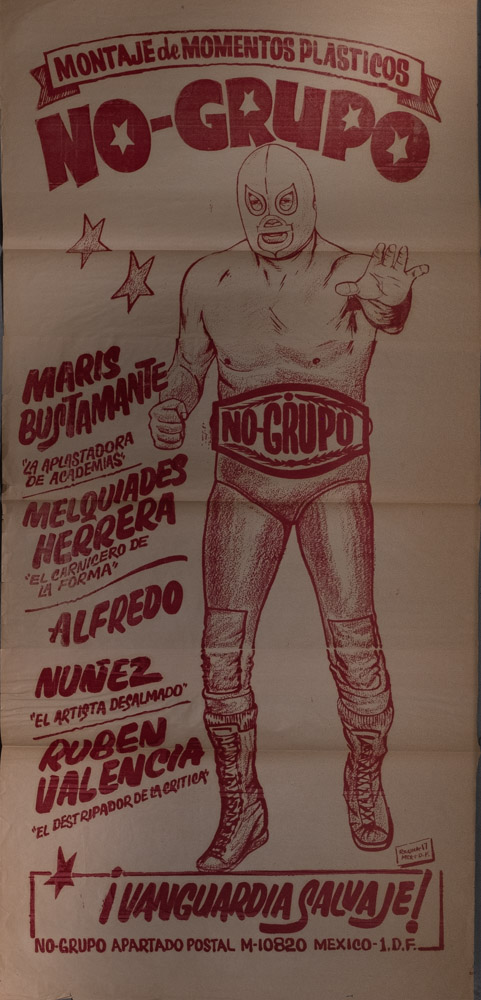
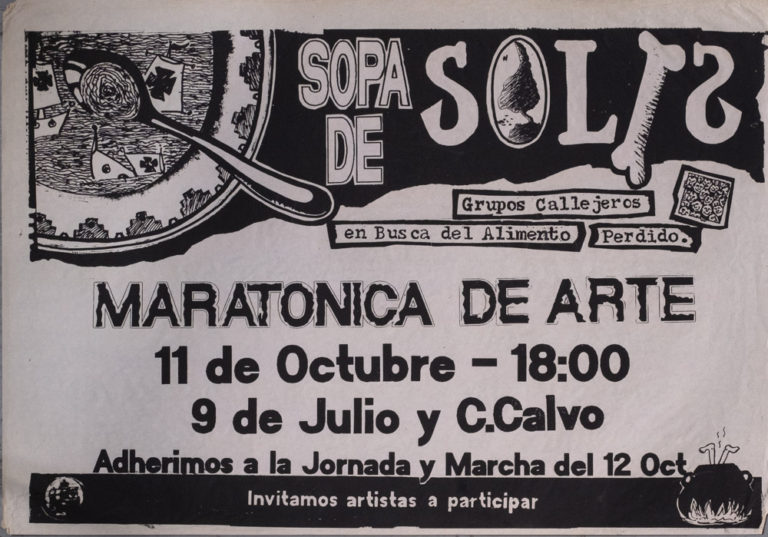
Entrevista con Ignacio Sourrouille por Ruth Benítez, Mayo 2020
Interview with Ignacio Sourrouille by Ruth Benítez, May 2020,e-mail
Cuál fue su primera impresión al llegar a Nueva York en 1994?
Bueno, fue algo hermoso. Recuerdo que llevábamos las obras en rollos de papel grandes bien embalados y en el aeropuerto Kennedy nos preguntaron:-qué llevan ahí? -Posters contestamos y nos dejaron pasar. Luego en el camino recuerdo haber visto el cementerio y al final llegamos al 112. Franklin street. Nos recibieron de la mejor manera, Martha, Harley, Michael, Raúl, Silver, Anita y más personas amorosas cuyos nombres no recuerdo. Todos muy generosos, -entre otras cosas- Martha nos consiguió vivienda en un local en alquiler en su departamento de Brooklyn, Harley nos llevó de paseos maravillosos. Michael nos invitó a cenar a su casa con vinos argentinos y compartimos anécdotas muy graciosas. Nos agasajaron e hicieron sentir como personas importantes, llegamos a una ciudad soñada y desconocida con la sensación -luego certeza- de ya tener amigos que nos estaban esperando y con quienes convivimos de la mejor manera.
Nos pueden contar sobre su experiencia la noche que fueron a Soho? De quien fue la idea, y porque decidieron ir a Soho? Nos podrían describir qué diferentes y similares eran sus expectaciones a lo que fueron sus experiencias reales? ¿Fue diferente hacer graffiti en Nueva York que en Buenos Aires?
Bueno, – resumiendo- nosotros éramos básicamente un grupo de “arte callejero”.La decisión de ir a Soho, fué simplemente porque estábamos allí, así que salimos a hacer nuestro trabajo como artistas profesionales, caminando por las calles, con una escalera, los serigrafías impresos, las plantillas de tv, los aerosoles y demás en un carro de supermercado. No sabíamos nada de la ley y nadie nos previno sobre si convenía esto ó aquello. Fué así que -entre otras obras- en un hermoso paredón separado por columnas dejamos 5 televisores grafiteados con las imágenes en papel pegados de pantalla. Y la gente a los días intento despegarlas por lo que las imágenes se rompieron. Entonces decidimos ir a restaurarlas. Fue ahí que en un momento salió un vecino WASP [White Anglo-saxon Protestant (Protestante Anglosajón Blanco Americano)] y me tomó del cuello y me amenazó con pegarme con un palo mientras ya había llamado a la policía. Lo demás fué que nos esposaron y gente que pasaba por allí que intentó defendernos argumentando que estábamos haciendo arte. De allí recuerdo que el cop me metió empujándome de una patada en el patrullero. Luego vino todo el episodio del precinto y la corte de justicia, el juicio rápido y la pena de hacer un día de trabajo para la comunidad, que consistió en limpiar el piso de todo un gimnasio. Julia por ser mujer fue separada y Dani por ser diabético fue al hospital. Ellos pasaron la noche y por ello no tuvieron multa ni pena ninguna. Así es que esta aventura superó con creces nuestra expectativa. La primera diferencia en hacer graffiti allá fué que los aerosoles eran muchísimo mejores que los que conseguimos aquí y con colores flúo además. La experiencia en sí de hacer nuestro trabajo no fué muy diferente en Buenos Aires que allá, salvo el detalle antes mencionado.
Nos pueden contar cómo se llegó a formar el grupo? ¿Cómo se conocieron? ¿Qué los inspiró a formar el grupo?
Bueno, a partir de una idea mía que estudiaba video en ésa época y casi nunca me dejaban tocar la cámara, decidí entonces ir por la autogestión y así convoqué a amigos/conocidos a formar un grupo de video donde hubiese rotación de roles. Llegamos a ser como 15 ó más, e intentábamos practicar con cámaras prestadas. Finalmente decidimos hacer una fiesta de fin de año para juntar dinero y así comprar nuestra cámara. Pero en la fiesta el fucking pelotudo que hacía de DJ, rompió los parlantes alquilados con lo cual el dinero recaudado tuvimos que usarlo para pagar los equipos rotos. Frustración, pasó el verano, y al comenzar el año casi desahuciados, el grupo se decantó en menos personas y empezamos a hacer collages con imágenes y a imprimirlas en serigrafía y poco a poco nos fuimos convirtiendo en un grupo de video sin cámara y arte callejero.
Hay algunos artistas que hayan influido en su trabajo y porque?
Bueno, hablando de artistas visuales, en mi caso muchos, por empezar mi madre Gunga, ceramista y los pintores Cachete Gonzalez y Lidia Tchira (padres de Federiso {Federico}) quienes me incentivaron a ser pintor. A nivel nacional, Federiso Gonzalez, Benito Quinquela Martin, Carlos Gorriarena, Rómulo Macció, Cándido López, Aida Carballo, Francisco Solano López. Internacionales: Pablo Picasso, Alexander Calder, Franz Masereel, Vincent Van Gogh, Francisco de Goya, Joaquín Sorolla, Marc Chagall etc.
What was your first impression when you arrived in New York in 1994?
Well, it was beautiful. I remember bringing my art wrapped in big rolls of paper and being asked, “What do you have there?” “Posters,” I said, so they let us pass. Then, on the walk over, I remember passing by a cemetery. Eventually, we arrived at 112 Franklin Street. They greeted us so warmly: Martha, Harley, Michael, Raúl, Silver, Anita, and others whose names I cannot remember. Everyone was very generous – among other things. Martha made accommodations for us in her Brooklyn apartment. Harley took us on marvelous excursions around the city. Michael invited us to dinner at his house. We shared anecdotes over some Argentinian wine. We They lavished us and made us feel like important people. We had arrived in an unfamiliar city we had dreamed of with an inkling, but later with a certainty that we already had friends that were waiting for us and with whom we shared experiences in the best way.
Can you tell us what it was like visiting Soho for the first time? Whose idea was it to go, and why did they decide on Soho? Was it what you expected, or was it really different? How did making graffiti in New York differ from in Buenos Aires?
Well, we were basically a group of “street artists.” The decision to go to Soho was simply because we were there, so we went out to do our job as professional artists. We walked down the street carrying a ladder, silk-screen prints, TV screen stencils, spray paint, and more in a shopping cart. We didn’t know if it was against the law, but nobody told us it was not allowed. One of the works we made was on a beautiful columned wall where we graffitied five televisions with posters as screens. And people tried to take them down and damaged the images, so we decided to repair them. It was then that a WASP [White Anglo-saxon Protestant] resident came out and grabbed me by the neck, threatening to hit me with a stick; he had already called the police. When the police came, we were handcuffed, but people who were passing by tried to defend us, saying that we were making art. I remember being kicked into a patrol car by a cop. Then there was the episode at the precinct and the court. We were tried quickly and sentenced to one day of community service: cleaning the floors of an entire gym. Julia was separated from the group because she is a woman and Dani was sent to the hospital because he was diabetic. Because Julia and Dani spent the night elsewhere, they didn’t get fined or punished. So, this adventure was wildly unexpected. The main difference making graffiti in New York is the aerosol paints. The ones we got there were much better than the ones we were able to get in Buenos Aires; not to mention there were even neon paints! Other than that, the experience of making graffiti in New York wasn’t too different.
Can you talk about how your group was formed? What was the group called? What inspired you to form the group?
Well, while I was studying videography, I rarely got a chance to use a camera. I decided to start my own group with friends and acquaintances where we routinely rotated roles. There were fifteen or more of us and we practiced on rented cameras. We decided to have an end of the year party and all pitch in to buy our own camera. But during the party, the fucking DJ broke the rented speakers. We ended up using the money we raised to pay for the damages. Frustrated, the summer passed, and by the start of the new year, we felt hopeless. Some people left the group, but we began making collages and printed them onto silk-screens. Little by little, we became a cameraless video and street art group.
What artists have influenced your work and why?
Well, if we’re talking about visual artists, there are many. To begin, there’s my mom, Gunga, who is a ceramist. And painters Cachete Gonzalez and Lidia Tchira (Federiso’s parents) who inspired me to become a painter. At the national level, Federiso Gonzalez, Benito Quinquela Martin, Carlos Gorriarena, Rómulo Macció, Cándido López, Aida Carballo, Francisco Solano López. And international: Pablo Picasso, Alexander Calder, Franz Masereel, Vincent Van Gogh, Francisco de Goya, Joaquín Sorolla, Marc Chagall etc.
Por el Ojo
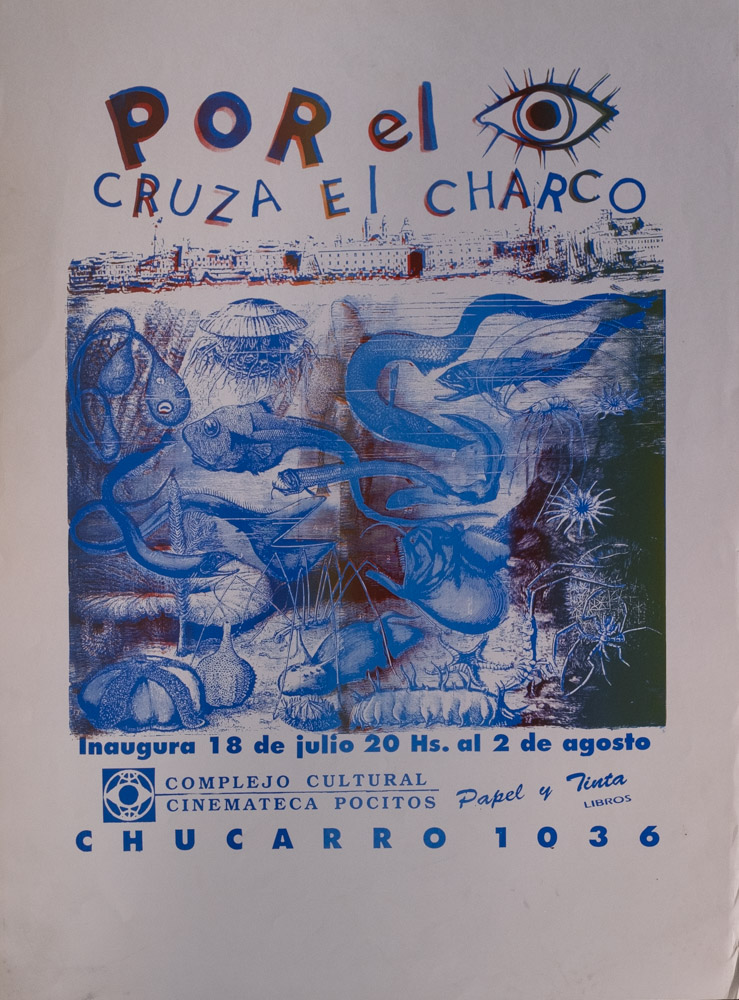
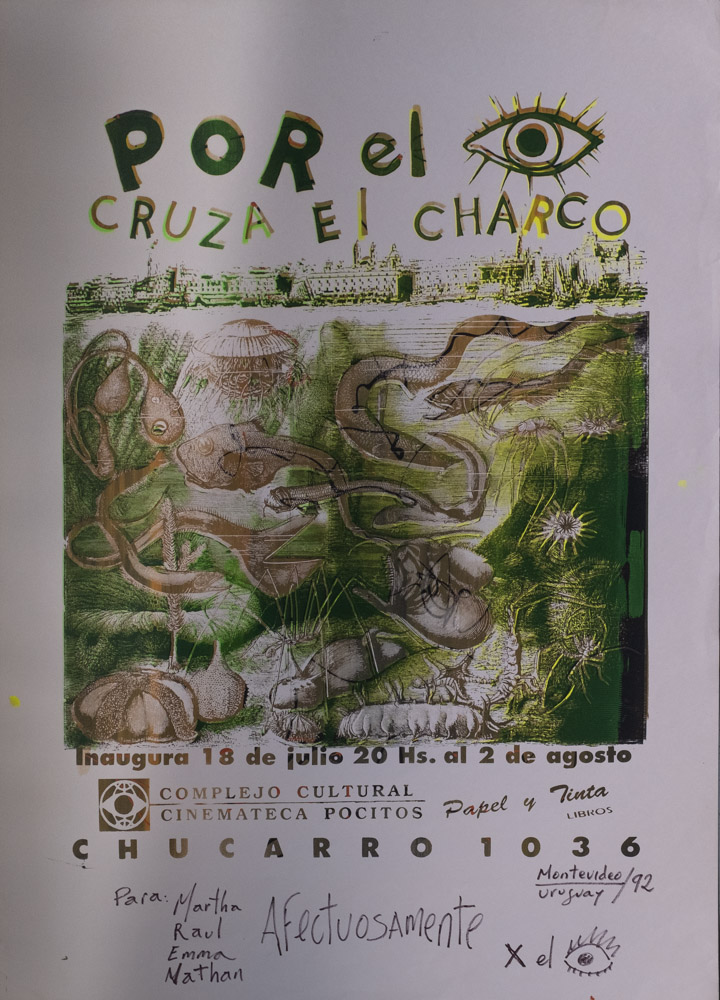
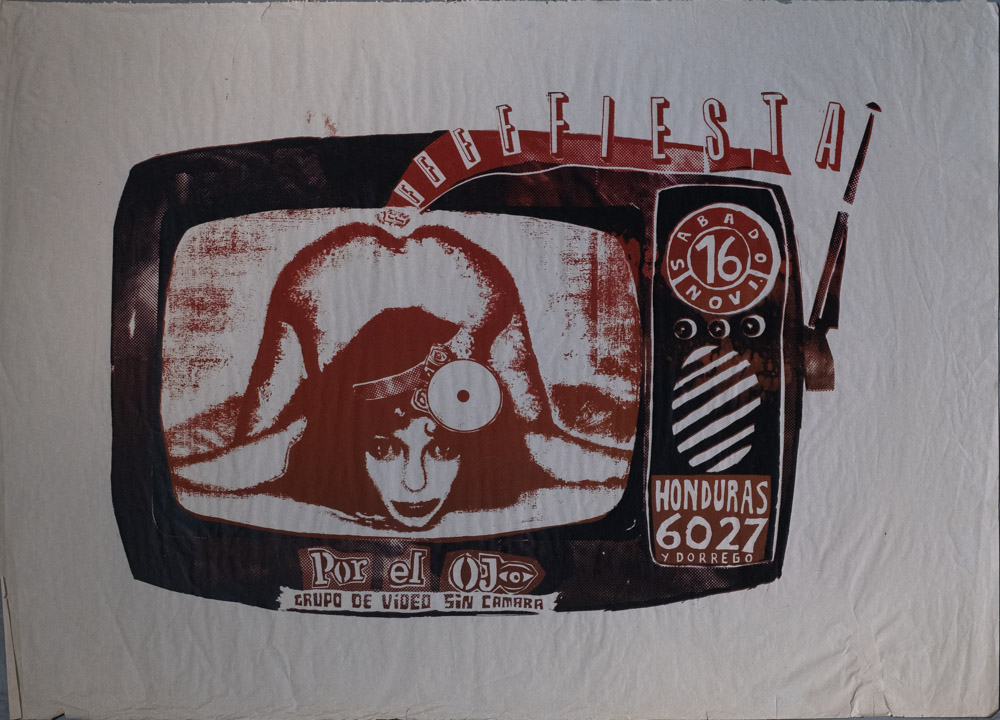
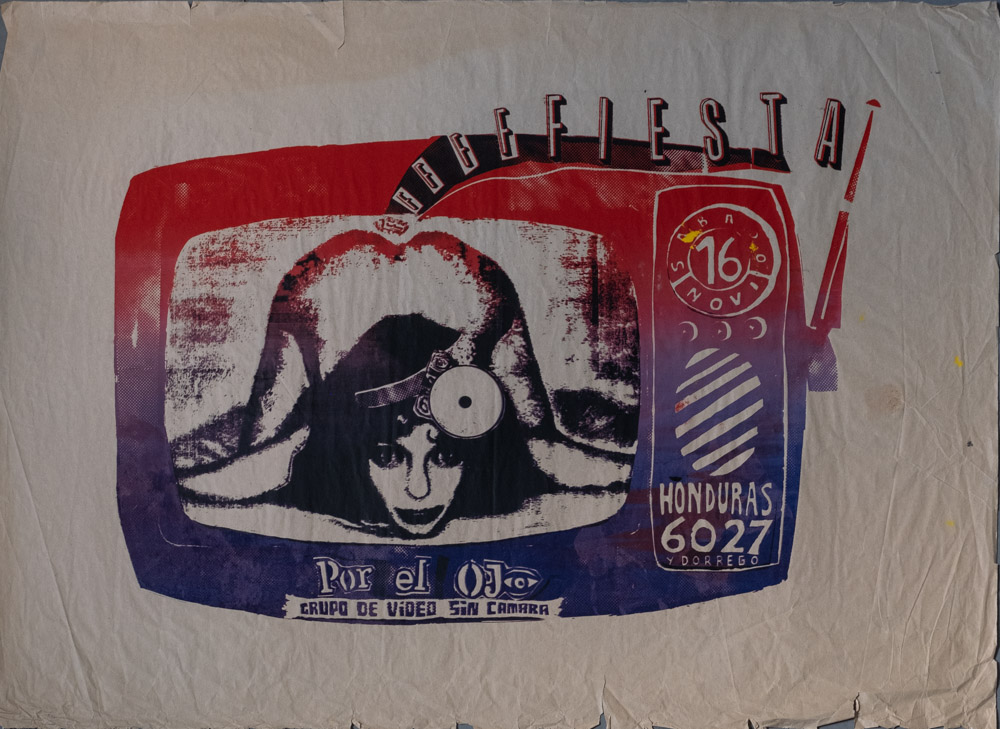
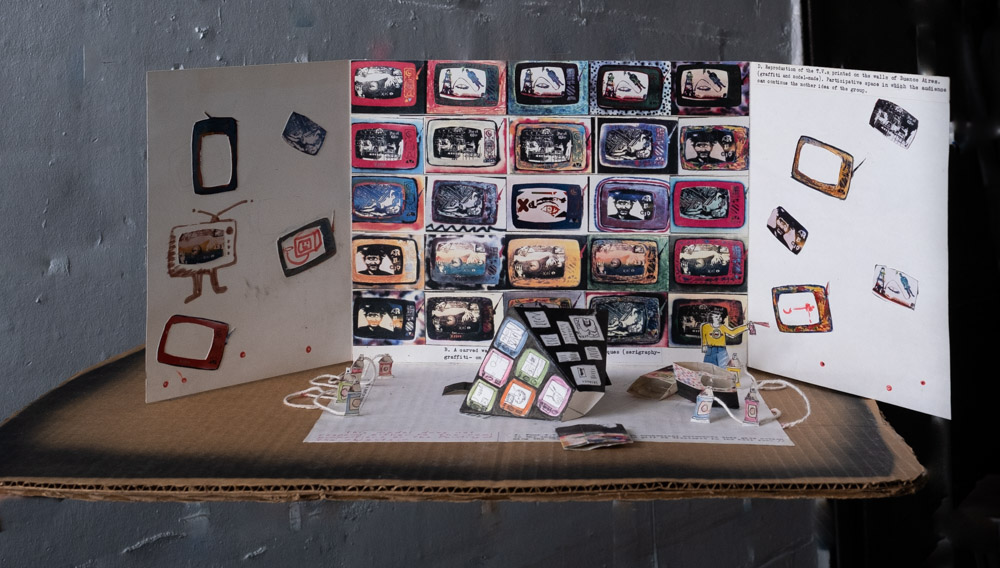
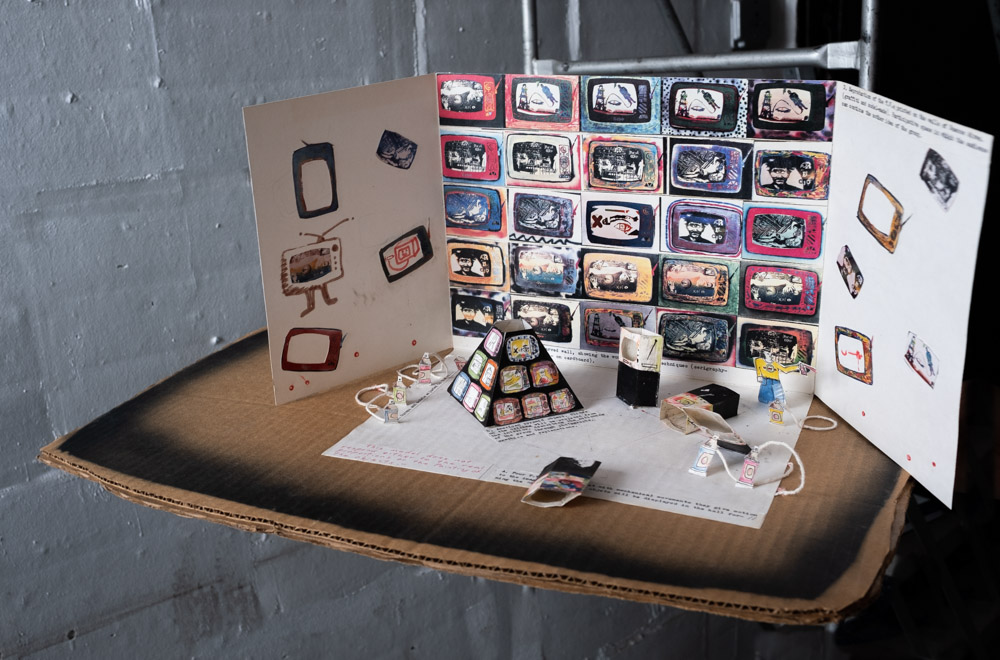
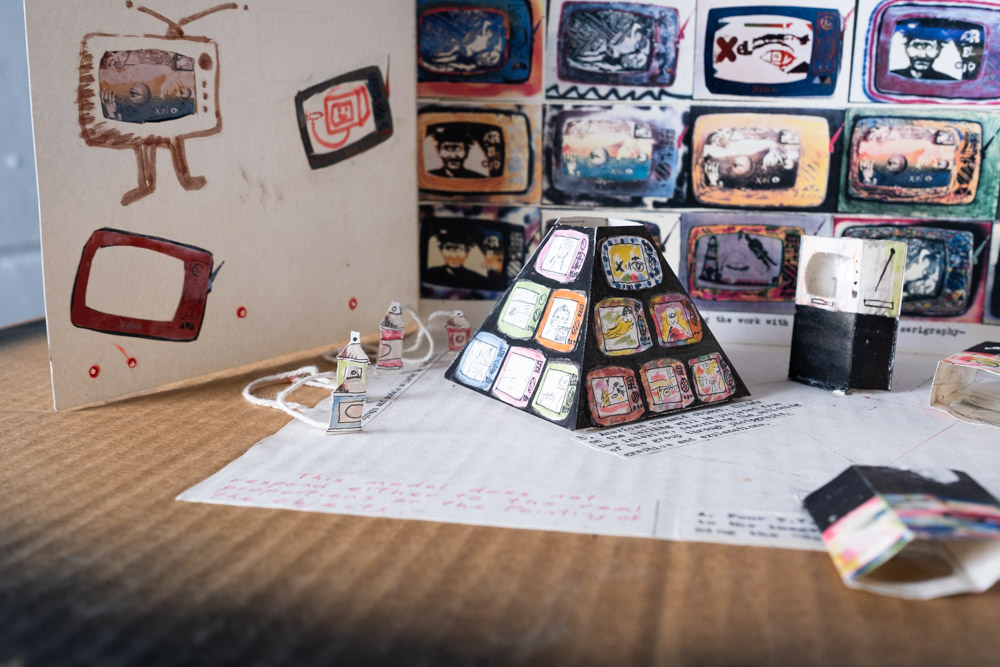
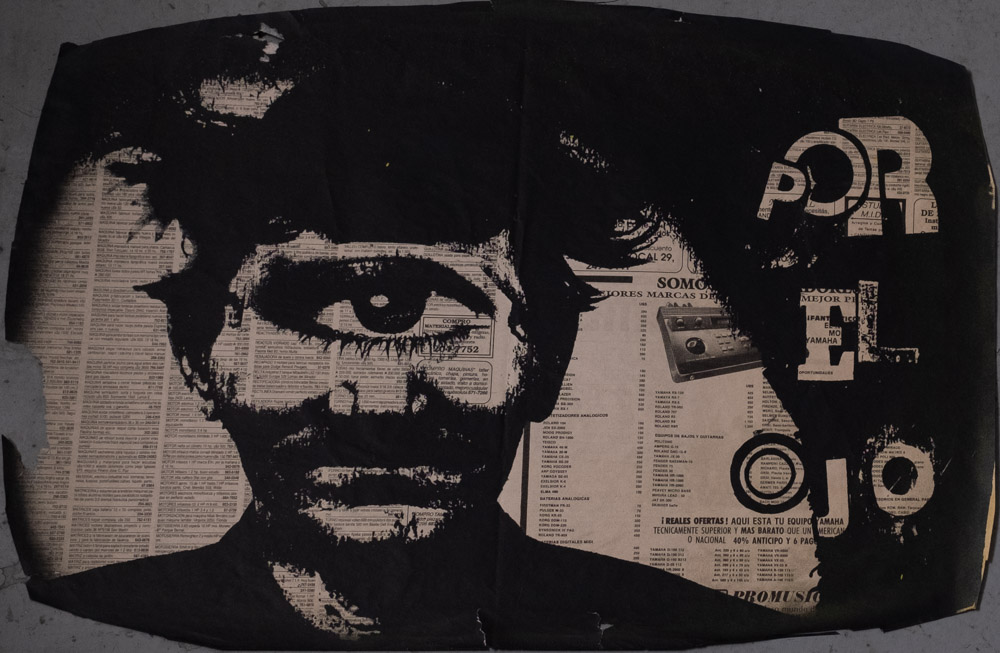
Entrevista con Federico Gonzalez por Ruth Benítez, Mayo 2020, correo electrónico
Interview with Por el Ojo with Federico Gonzalez by Ruth Benítez, May 2020, e-mail
Amigos y amigas de FF, acá van las respuestas.
Sobre la primera impresión:
Llegamos a N.Y. un día de mayo de 1994 a las 6 de la mañana, en la terminal de migraciones del aeropuerto presenté mi documentación a un hombre visiblemente fastidiado por mi precario inglés, hablaba a los gritos y de mala manera, decidí cambiar de terminal con mejor suerte.
Del otro lado nos recibió Raúl, trabajador de la F.F. de origen mexicano, alto, con cara de piedra Olmeca. Nuestro equipaje parecía una mudanza, una vez en la van fue surgiendo la ciudad, los negocios estaban cerrados con sus persianas bajas, todo graffiteado con firmas y garabatos, nos miramos con cara de “qué carajo es esto”.
Esa misma noche Raúl nos llevó a una fiesta en Harlem, pero nos perdimos y caminamos muchas cuadras para un lado y para el otro detrás de él, un grupo de niños negros muy graciosos que lo confundieron con chino perdido le hacían bromas, al fin llegamos al Museo del Barrio, quedamos atrapados con una muestra de Álvarez Bravo, grupo de salsa y baile.
Nos alojaron en un local vacío en el edificio donde vivía Martha en Brooklyn y nos dieron una hermosa bienvenida en la F.F. de Tribeca.
Recuerdo entre las primeras impresiones el no entender por qué la ciudad estaba toda rayada con firmas y palabras, el buscar paredes para intervenir desde nuestra llegada y la calidez y confianza que nos brindaron los compañeros y compañeras de la Franklin. También encontrar un gran intercambio, integración y solidaridad en el mundo del arte.
Sobre la noche en Soho:
Pasamos una semana trabajando en el sótano de la Franklin para montar la muestra, usamos materiales encontrados en la calle y en la fotocopiadora hicimos la gráfica artesanalmente, fuimos construyendo allí lo que fue la primera puesta; siempre el eje de nuestro trabajo estuvo designado por el nombre del grupo: Por el Ojo.
Trabajábamos y tomábamos decisiones siempre de forma colectiva, más que sumar multiplicábamos las individualidades y no respondíamos a la coyuntura política inmediata ni éramos el ala artística de un partido u organización social, tampoco interveníamos como grupo en los lugares de conflicto, más bien tomamos el espacio público como un lugar en disputa y al arte callejero como obra colectiva, en esta disputa incluíamos el espacio virtual. Los medios de comunicación configuraban su arquitectura de poder hegemónico, nosotros lo plasmábamos encerrando las imágenes en marcos de televisor en tanto las asimetrías tecnológicas nos llevaron a la tercermundista descripción “Video sin cámara”.
El colectivo era dinámico y anárquico en su accionar (no como cuenta el relato de algunos comisarios de la historia que necesitaron de un líder para armar su hilo y le dieron a Daniel ese rol para unir sus acciones con la de otros grupos en los que había participado y así facilitar la ficción, algunos historiadores son más vanguardistas que las mismas producciones de los artistas; la lógica de liderazgo derrumba como tal la construcción colectiva)
Una vez inaugurada la muestra en la Franklin salimos a trabajar a la calle, igual que en Buenos Aires en jornadas interminables donde sabíamos hacia dónde pero siempre terminábamos improvisando, ya sea en el recorrido como en lo creativo. Muchas noches salimos de la F.F. rumbo a Soho con un carrito de supermercado cargado de materiales, tuvimos mucho intercambio con la gente incluso con la policía que nos preguntaban que hacíamos pero no nos detenían, varias noches pintamos hasta el amanecer, éramos felices; en Nueva York surgieron nuevas ideas y formas de trabajar, siempre al límite y sobre la misma pared aparecía la idea.
Una noche se nos dio por hacer un retoque a una intervención y de repente una persona con un fierro largo nos comienza a amenazar violentamente, luego llega la policía, se junta mucha gente que nos apoyaba. Esa persona era un vecino que nos denunció porque le habíamos grafiteado su casa y le correspondía una multa, no lo sabíamos pero ya estaba en marcha la tolerancia 0 de Rudy Giuliani.
Orígenes:
El grupo se formó en el 89 luego de hacer una experiencia de estudio de video que fue una iniciativa de Ignacio, éramos como 10/12 personas que durante un año nos juntamos a hacer guiones y prácticas con cámaras prestadas, un día hicimos una fiesta para conseguir el dinero para comprar una cámara, nos fue muy bien, habíamos juntado unas 300 personas y la recaudación alcanzaba. Al amanecer el encargado de técnica hace una errada conexión y quema todos los equipos de audio que nos habían prestado, chau cámara.
El grupo se desinfla y quedamos 5, Alfredo olivera que al año siguiente funda la radio La Colifata en el hospital neuropsiquiátrico, Ignacio y Julia que venían trabajando con fotografía y Daniel y yo que veníamos de las artes visuales. Daniel con los grupos gráficos y performáticos ligados al Trotskismo y a los artistas Emei y Coco Bedoya, y yo llevaba unos años experimentando con el arte callejero, pintaba pasillos circulares, televisores y satélites con rayos alienantes. Así del desconsuelo y la falta surgió el Video sin Cámara.
Lo que hacíamos no era considerado arte. El mundo del arte era lejano y ajeno para nosotros hasta que ganamos el premio de la F.F. en el 93 y se nos abren las puertas de los más de los más deseados espacios y logramos la colaboración de decenas de artistas con el grupo.
Influencia:
Para mi hubo una influencia muy importante de un artista anónimo que pintaba televisores con la frase “a falta de padres buenos son los tv.” En Buenos Aires en los 80’ recién salidos de la dictadura fuimos parte de una movida llamada Under que fue un verdadero despliegue colectivo de creatividad donde todos nos alimentabamos de todos, gente de teatro, de la música mezclada con poetas, artistas visuales y performers. También el descubrir a Antonio Berni y encontrar en la biblioteca de mi padre un pequeño libro de Frans Masereel el grabador Belga.
Friends of Franklin Furnace (FF), here are the responses:
My First Impression:
In May of 1994 we arrived in New York at around 6 am. I showed my documentation to the man at the immigration terminal. He became visibly frustrated with my poor English and started yelling, so I decided to change terminals in hopes of better luck.
On the other side of customs, Raúl greeted us. He was one of the employees at FF: Mexican, tall, and with a face like an Olmec head. We crammed so much luggage into the van, it looked like we were moving to live in New York. As the city started to emerge from the horizon, we saw all the businesses were closed with drawn blinds, graffitied in signatures and scribbles. We looked at each other as if to say, “What the fuck is this?”
That same night, Raúl took us to a party in Harlem, but we got lost and walked many blocks in the wrong direction. On the way back in the right direction, a group of very funny Black kids mistook Raúl for a lost Chinese person and made jokes about him. At last, we got to El Museo del Barrio. When we arrived, we became entranced by Álvarez Bravo, a salsa group that was performing.
We were housed in an empty apartment in the Brooklyn complex Martha lived in and received a warm welcome at Franklin Furnace in Tribeca.
So, of all the things I saw that day, I remember most vividly the strangeness of seeing a city covered in signatures and words, and searching for walls to graffiti and cause an interference since the moment we arrived, and the warmth and confidence FF gave us. I found solidarity in the fluid integration and exchange of ideas within the art world.
The Night in Soho:
We spent the week working in the basement of Franklin preparing for the show using things we found on the street and artisanal graphics made with a photocopier; we were constructing our first installation piece; the focus of our work was reflected in the name of our group: Por el Ojo (Through the eye).
We always worked and made decisions as a group rather than retroactively combining separate ideas. As a group, we were more than our individual identities, more than just the sum of our parts. The group wasn’t formed in response to the immediate political situation, nor was it affiliated with a party or social organization, nor did we intervene in places with conflict; rather, we viewed public spaces as places of dispute and saw street art as a collective work; we included the virtual space in this dispute. Our art satirically mirrored the media’s power to maintain the architecture of hegemonic power by encasing images in TV frames. The technological restrictions we had inspired us to describe the work with a third world saying, “Video without camera.”
It was a dynamic artist collective and anarchic in its actions (unlike in some historical accounts which used Daniel as the lead figure in their fabricated narrative. He was the connecting thread between the different artist groups in which he was a part of. The historians used leadership to destroy the collective; in this way, the narratives of the historians were more avant-garde than the works of the artists.)
When the exhibit was finished in Franklin, we went to work on the street. Like in Buenos Aires, the workdays felt endless. We knew the direction in which we were going in but always ended up improvising, in both the cardinal and creative sense. On many nights, we left FF for Soho with a shopping cart full of supplies. We had many exchanges with people and police who asked what we were doing, but no one stopped us. Some nights, we painted until dawn, we were so happy. Whilst in New York, we discovered new ideas and ways of working and always pushed those ideas to the limit and painted them on that very same wall.
One night, while we were doing some touch-ups, a person suddenly started violently threatening us with a long iron rod. The police arrived, and a lot of people came together to support us. The person, who was a resident, was angry because we had graffitied his house and wanted retribution. We didn’t know about it, but Rudy Giuliani’s zero tolerance policing policy [which cracked down on minor crimes] was already in place.
Origins:
It was Ignacio’s initiative to form the group in ‘89 as a way to experience video making. The original 10 to 12 people spent the first year on writing scripts and practicing on borrowed cameras. One day, we hosted a party to raise money to buy our own camera; it went well. About 300 people attended and we reached our fundraising goal. But at dawn, the DJ made a mistake and short circuited all the audio equipment we had rented. Ciao camera.
After that incident, group membership dwindled leaving only five of us. There was Alfredo Olivera who would found a radio show, La Colifata, whilst at a neuropsychiatric hospital; Ignacio and Julia who had been working in photography; Daniel and I who came from visual arts. Daniel was in graphic and performative arts groups associated with Trotskyism and the artists Emei and Coco Bedoya. I had been experimenting with street art for a couple years, painting circular hallways, televisions, and satellites emitting alienating rays. So the group, Video sin Cámara (Video Without Camera), came out of our grief and lack of equipment and funds.
What we made wasn’t considered art. The art “world” was distant and closed off to us until we won the FF grant in ’93. The grant opened so many doors for us, allowing us to work in new spaces and collaborate with dozens of other artists.
Influences:
I was heavily influenced by an anonymous artist who painted televisions captioned with the phrase, “a falta de padres buenos son los tv (because of the lack of good parents, there are TVs).” During the 80s in Buenos Aires, the dictatorship had just ended when we became part of the Under movement which was a complete unraveling of a collective creativity. We fed off of each other’s ideas, those of theater performers, musical poetry, visual artists and other performers. There was also the discovery of Antonio Berni and a small book by Frans Masereel, the Belgian engraver, in my father’s library.
Postcards & Flyers
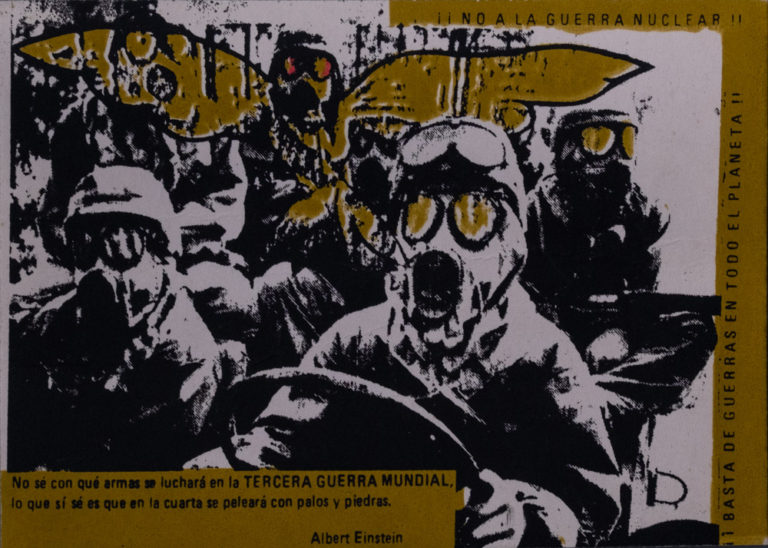
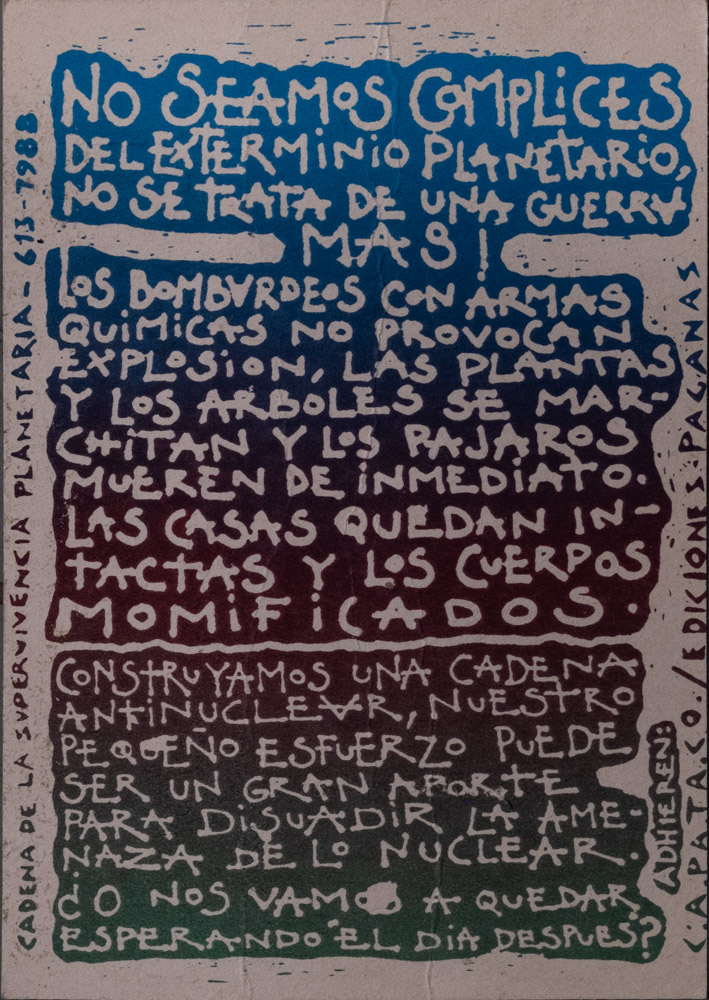
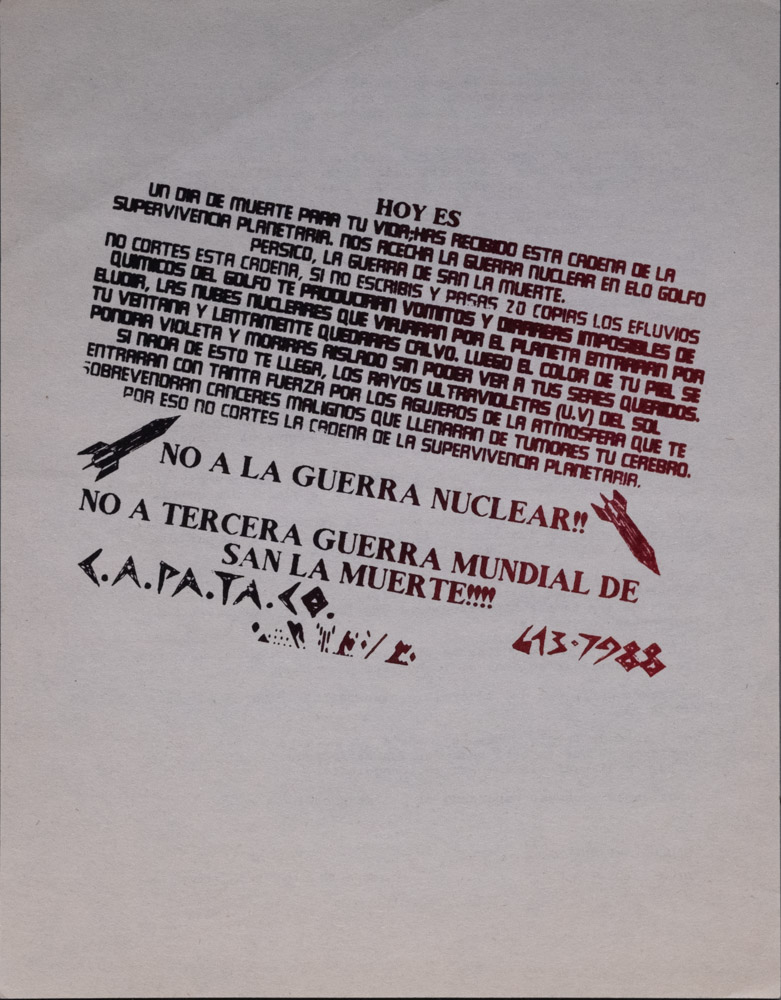
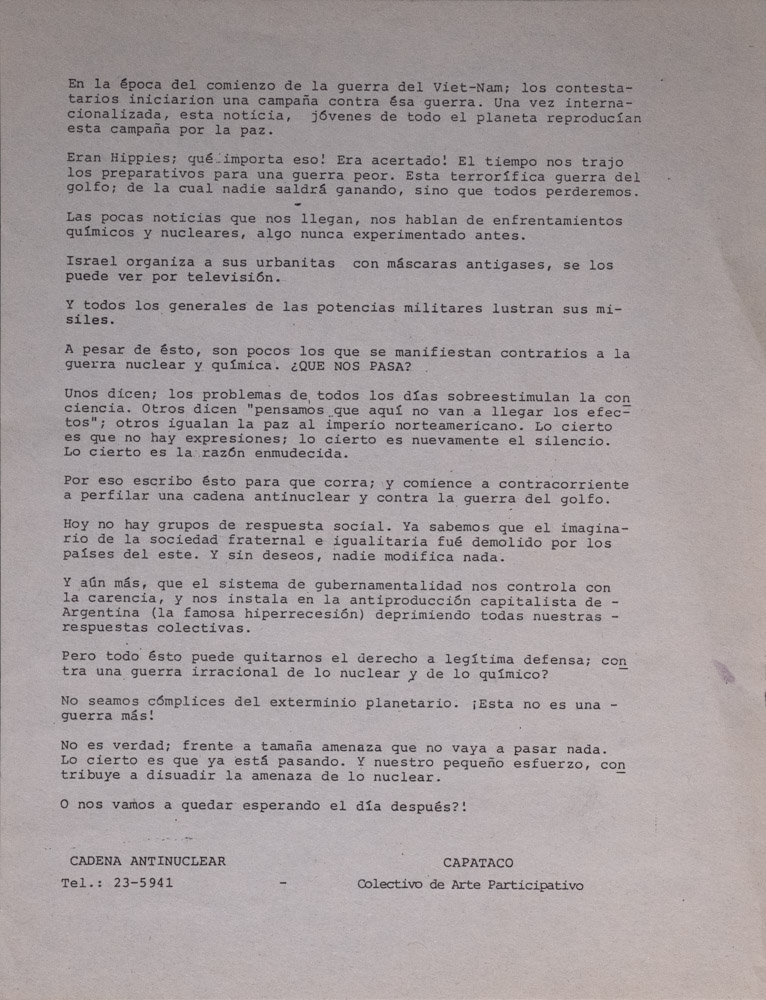
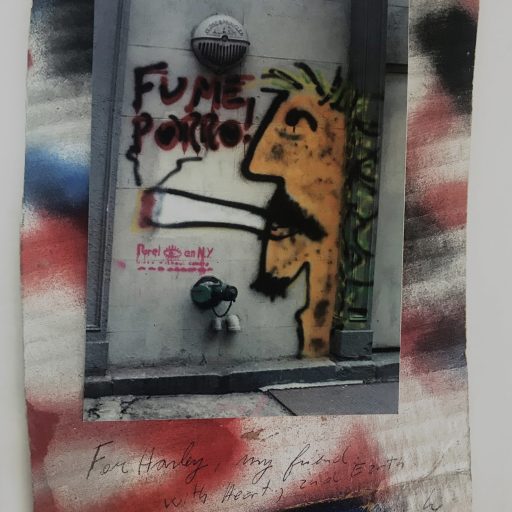
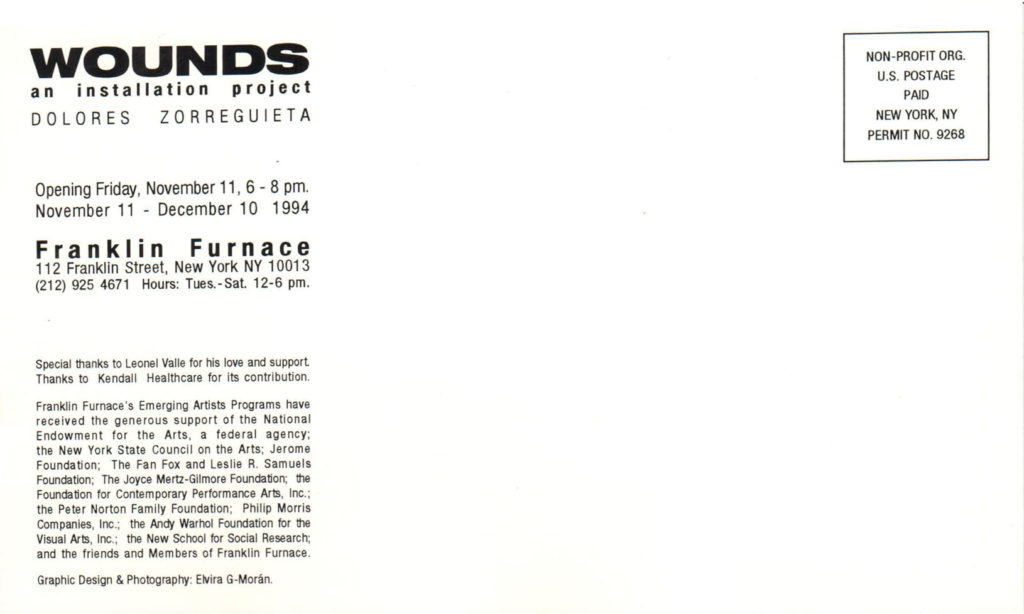
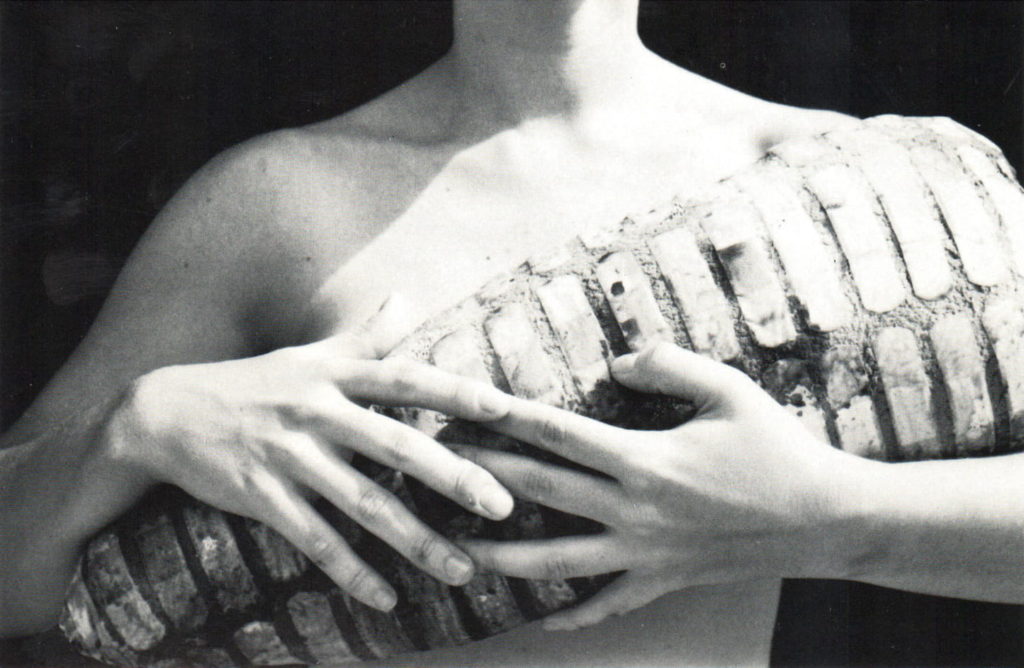
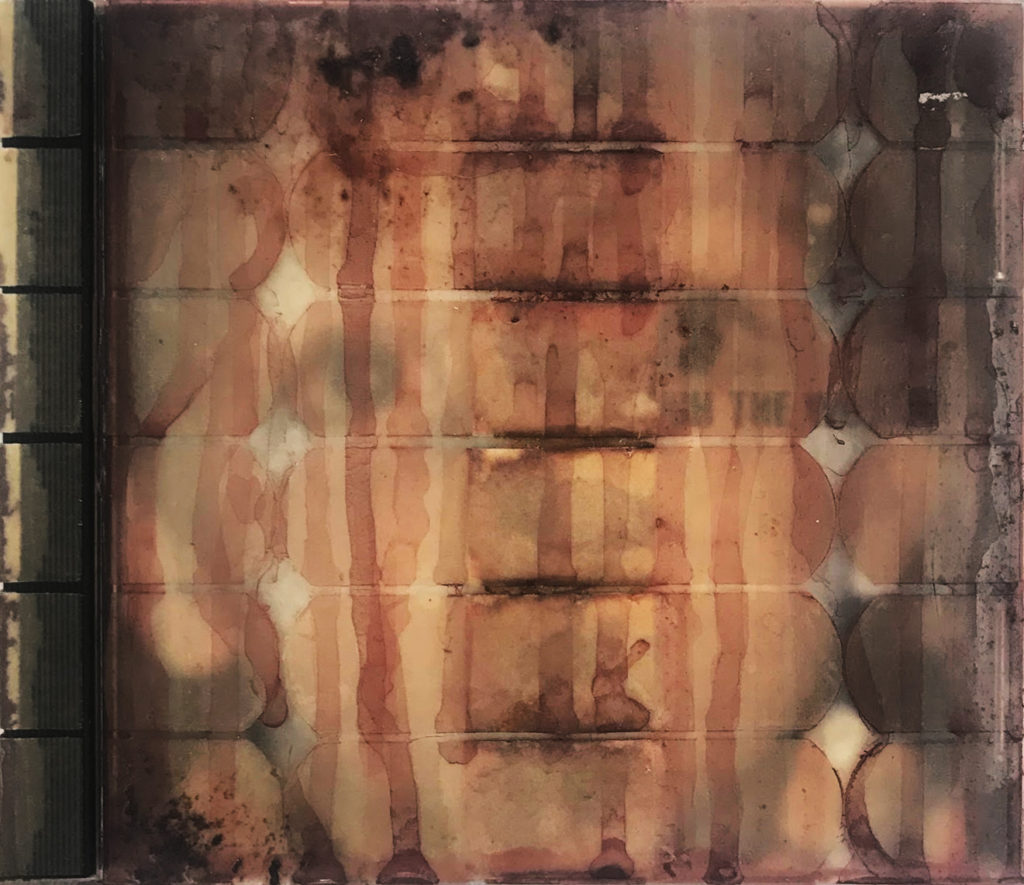
Entrevista con Dolores Zorreguieta por Ruth Benítez, Junio 2020, correo electrónico
Interview with Dolores Zorreguieta by Ruth Benítez, June 2020,
e-mail
¿Cómo fue su experiencia con la “Guerra Sucia”?
Tenía diez años cuando pasó el golpe de estado en Argentina. Recuerdo que era una época muy confusa e incierta, en la que muchas cosas pasaban y los adultos guardaban muchos secretos y no le daban explicaciones a los jóvenes. Entonces crecí con una realidad poco clara como un fondo, cargada de medias verdades, información falsa en una sociedad represiva. Paradójicamente, en mi casa, mi madre construyó una cultura muy abierta donde la música, el arte, la danza, y la literatura estaban disponibles y me moldearon. Y como muchas veces pasa con los niños, a pesar del giro trágico que el país tomó, yo era por la mayor parte una niña feliz con una educación estimulante y una verdadera sensación de libertad en mi casa. Me sentía realmente querida, no solo por mi mamá, sino también por mis hermanas, Maria y Angeles. La escuela secundaria fue más difícil y definitivamente rara: empezó con la Copa Mundial de Fútbol que tomó lugar en Argentina en el 1978 durante el peor tiempo de las desapariciones de Argentinos, y terminó con La Guerra de las Malvinas y con el colapso final del país antes del regreso a la democracia. Si tuviera que nombrar algunos sentimientos de esa época, esta sería mi lista: euphoria, horror, tristeza y miedo a un fin catastrófico y el día de rendición. Todo esto mientras navegaba una de las adolescencias más incómodas, y poquito a poquito me iba dando cuenta que quería ser una artista, y al hacerlo empecé a analizar mi lugar en el mundo. Fue el principio de un nacimiento, regocijante y atormentante al mismo tiempo.
¿Siente que es necesario separar su vida personal de su arte para poder dejar que el arte hable sobre asuntos difíciles y aun sentir paz?
Yo no puedo separar mi vida personal de mi arte, no creo que ninguna persona lo pueda hacer. En mi tesis de artista digo que mi trayecto artístico revela un esfuerzo de toda la vida que intenta navegar las fronteras entre la culpabilidad y la inocencia, tratando de soulinear la medida precisa de la responsabilidad personal y colectiva el enfrentar la violencia. A causa de la involucración de mi papá en la dictadura, la mayor parte de mi vida llevé esa culpa vieja y bíblica, esta idea alrededor de los pecados del Padre… y quizás el arte me ofreció un ruedo para construir la respuesta más competente para resolver -hasta cierto nivel- ese conflicto. Creo que en todo caso, el arte me ha dado una oportunidad, a veces dolorosa y desorientadora, de explorar zonas que serían inhóspitas en cualquier otra práctica. Como dijo Louise Bourgeois: “Todos los días tienes que abandonar tu pasado o aceptarlo, y entonces si no lo puedes aceptar te conviertes en un escultor.” No se trata de separar tu vida personal, o como dijo ella, es en realidad la inhabilidad de separar o aceptar algo que empuja a muchos artistas a hacer arte. En ese sentido el arte permite cierto tipo de exorcismo.
¿Juega algún papel tu arte en la reconciliación, de lo que parece ser un deseo humano universal, entre la paz y la felicidad con las atrocidades que has visto?
No creo que mi arte tenga el poder de reconciliar, o para decirlo de mejor forma: no creo que la reconciliation es la motivación detrás de mis obras. En realidad cuando tiene que ver con mis obras más políticas, creo que el arte es más como un campo de batalla, un lugar de confrontación. Tal vez para mi representa un lugar seguro para pelear guerras pasadas, presentes y futuras, y de alguna manera en el proceso yo puedo tener acceso a algún tipo de paz. Al mismo tiempo no creo que mis obras, especialmente las piezas que directamente tratan la violencia, puedan ofrecer reconciliation o paz al espectador. En algunos casos los espectadores piensan que mi trabajo en sí es un acto agresivo. No me podría oponer…
¿Te sorprendes a ti misma al ver el resultado final de tus piezas?
Si, muchas veces. En algunos casos una idea se presenta con un camino claro de ejecución y de alguna manera un resultado claro. Otras veces exploró territorios que son inciertas de manera temática o técnica que me llevan a un resultado sorprendente que no tiene nada que ver con lo que pensaba que estaba creando. La primera pasa muy pocas veces y cuando hago piezas así son mis milagritos. La segunda puede ser increíblemente frustrante o verdaderamente gratificante y es la experiencia más común para mi.
What was your experience like with the “Dirty War”?
I was ten years old when the coup d’état happened in Argentina. I remember that period as a very convulsive and confusing time, when a lot of things happened and adults were very secretive and gave no explanations to youngsters, so I grew up with an unclear reality as a backdrop, packed with half trues, misinformation in a repressive society. Paradoxically, at home, my mother built a very open culture where music, art, dance, literature were available and shaped me. So like often happens with kids, despite the tragic turn the country took, I was for the most part a happy girl with a stimulating education and a real sense of freedom at home. I felt truly nurtured not only by my mother but my two sisters, María and Angeles. High school was more difficult and definitely stranger: it started with Argentina hosting the Soccer World Cup in 1978 during the worst time of the disappearance of Argentineans, and it ended with La guerra de las Malvinas and the final collapse of the country before the return to democracy. If I have to name few of the sentiments of the time, this would be my list: euphoria, horror, sadness and catastrophic doom, and fear of the final reckoning. All of this, as I was navigating the most awkward of adolescence, and little by little I was realizing I wanted to be an artist, and by doing so I was starting to assess my place in the world. It was the beginning of an awakening, exhilarating and tormenting at the same time.
Do you feel that it’s necessary for you to separate your personal life from your art in order to let it address tough issues and still be able to feel at peace?
I cannot separate my personal life from my art, I don’t think anyone can. In my artist statement I say that my artistic journey reveals a lifelong effort to map down the boundaries between guilt and innocence, trying to outline the exact measure of both personal and collective responsibility in the face of violence. Most of my life because of my father’s involvement with the dictatorship I dealt with that old biblical guilt, this idea around the sins of the Father… and maybe art offered me an arena to build the most competent response to solve -to some degree- that conflict. I think if anything, art has given me an opportunity, at times painful and disorienting, to explore areas that would be inhospitable in any other field. Like Louise Bourgeois said: “Every day you have to abandon your past or accept it, and then, if you cannot accept it, you become a sculptor.” It is not about separating your personal life, or like she said, it is actually the inability to separate or accept something that pushes many artists to make art. In that regard art allows some kind of exorcism.
Does your art play a role in reconciling what seems to be a universal human wish for peace and happiness with the atrocities you have experienced?
I don’t think my art has the power to reconcile, or to say it better: I don’t think that reconciliation is the motivation behind my work. In fact when it comes to my most political work, I think art is more of a battlefield, a place of confrontation. Maybe for me it represents a safe place to fight past, present and future wars, and somehow in the process I can access some kind of peace. At the same time I don’t think that my work, especially the pieces that directly address violence, can offer the viewer reconciliation or peace, in some cases viewers even think my work is an act of aggressiveness on its own. I wouldn’t feel strong enough to disagree…
Do you ever surprise yourself with the end result of your pieces?
Yes, many times. In some cases an idea presents itself with a clear path of execution and a somehow clear outcome. Other times I explore uncertain territories both thematically or technically that lead me to a surprising result that may have nothing to do with what I thought I was creating. The former happens very few times and when I create pieces like that I consider them little miracles. The latter can be awfully frustrating or truly rewarding and it is the most common experience for me.
Artists' Books
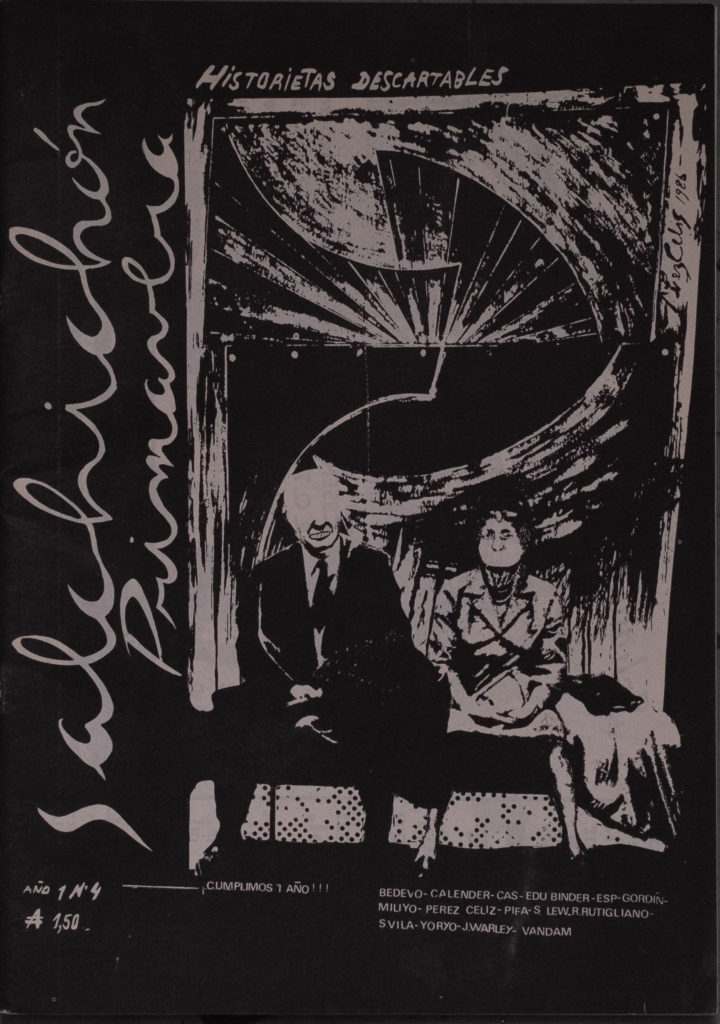

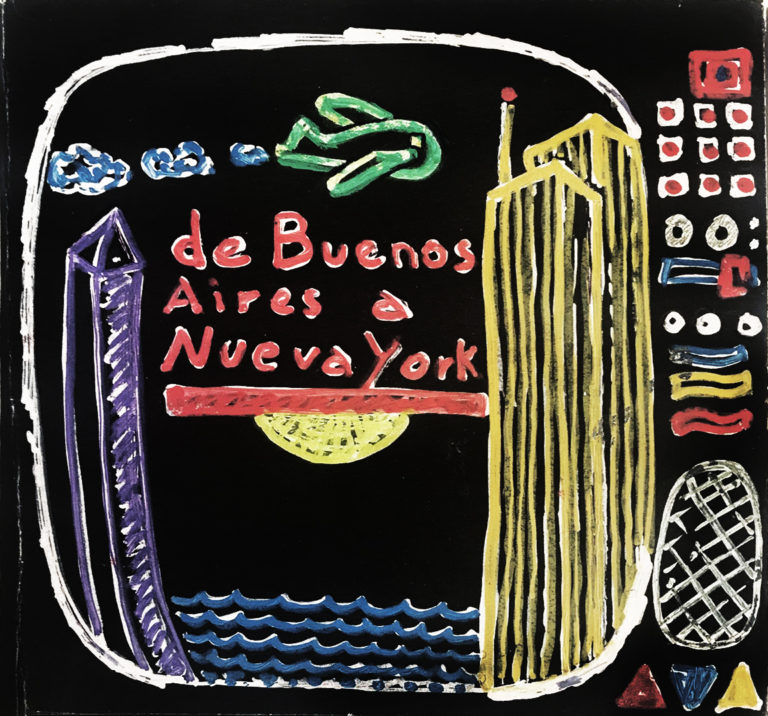
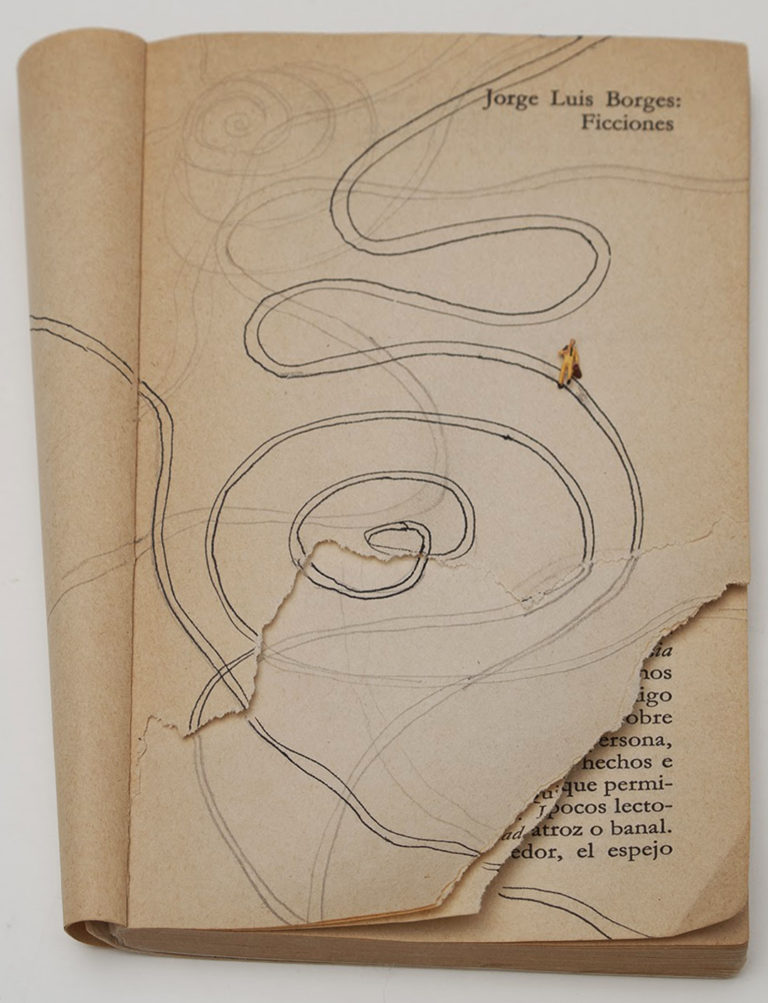
Entrevista con Liliana Porter por Ruth Benítez, Mayo 2020, correo electrónico
Interview with Liliana Porter by Ruth Benítez, May 2020, e-mail
¿Cuál fue la razón que te llevó a elegir Ficciones de Jorge Luis Borges como fuente de inspiración? ¿Cómo fue la experiencia de volver a trabajar con este libro? Durante la realización de esta obra, ¿Qué reflexiones te surgieron, considerando que la realizabas para una exposición sobre el arte político de los años 1980 a los 1990s?
Cuando me invitaste a esta exhibición, me preguntaste si tengo algunas obras relacionadas con el libro de Ficciones, aunque he hecho otras obras que refieren a Borges, no tenía una obra pequeña. Pero siendo que Borges es mi escritor favorito, tenía una buena edición en español de Ficciones que fue perfecta para intervenir. Decidí crear una nueva obra con el sujeto del viajero. En las primeras páginas, dibujé muchas líneas con lápiz y tinta que representan los cruces de varios caminos. El libro está abierto y doblado. Encima está una figurita sujeta a uno de los caminos. Algunas páginas están arrancadas y es posible leer el título de Ficciones en la parte superior de la página. En otra página, es posible echar un vistazo de la palabra “espejo” (mirror), la que es muy Borgeana. La intervención gráfica de este libro podría ser interpretada como una metáfora del paso del tiempo. Ya estabas viviendo en Nueva York cuando ocurrió el golpe de estado en Argentina. ¿Te afectó la dictadura a ti o a tu arte de alguna manera? Creo que todas las experiencias de la vida afectan nuestra percepción de la realidad y por eso deben afectar nuestro arte, pero no siempre de una manera explícita. ¿Por qué te quedaste en Nueva York y cómo influyó tu arte? ¿Cómo fue tu relación con los otros artistas argentinos después de la llegada al EE.UU.; supiste de algunos artistas en exilio?
Cuando llegué a Nueva York en 1964, estaba planeando quedarme sólo por una semana para después continuar con mi viaje a Europa. Pero me impresionó tanto la ciudad y la escena artística que decidí quedarme por más tiempo. Tenía 23 años, así que Nueva York fue la mejor ubicación para concentrarme en mi arte, reflejar, y decidir el contenido e intenciones del arte.
Conocí a muchos artistas argentinos en Nueva York como Luis Felipe Noé, Sarah Grillo, y Marcelo Bonevardi que ya estaban trabajando en la ciudad.
Estoy segura de que conocí otros artistas exiliados porque conocí la mayoría de los artistas argentinos y latino americanos que estaban en Nueva York. Aunque algunos artistas llegaron a Nueva York en los años setenta, no era el destino preferido porque EE.UU. es conocido por haberse involucrado en las dictaduras de Latinoamérica.
¿Qué sabías sobre el arte argentino? ¿Cuál era su perspectiva desde el EE.UU.? ¿Puedes decir más sobre el Taller Gráfico de Nueva York? Estaba y todavía estoy interesada y consciente de lo que están haciendo mis colegas de Argentina. Estudié arte en la Escuela Nacional de Bellas Artes Manuel Belgrano en Buenos Aires, donde aprendí sobre varios artistas argentinos como Raquel Forner, Castagnino, Pettoruti, Spilimbergo, Berni, y muchos más.
Más tarde, cuando todavía estaba viviendo en Argentina, me di cuenta de la actividad en Buenos Aires del Grupo de la Nueva Figuración: Noé, Deira, de la Vega, Macció. Llegué a Nueva York en 1964 y estaba emocionada de conocer a los miembros del grupo que estaban allí y nos hicimos amigos. Tenía conexiones con otros artistas también como Juan Carlos Romero, Diana Dowek, quienes eran mis amigos, y luego conocí a Graciela Sacco también por nombrar algunos.
El Taller Gráfico de Nueva York estaba ubicado en Greenwich Village y fue fundado en 1965 por José Guillermo Castillo, Luis Camnitzer, y yo. Discutíamos e hicimos mucho arte allí. También teníamos estudiantes y ofrecíamos servicios de impresiones profesionales para el proceso de aguafuerte. Expusimos en grupo en varios lugares. Aspirábamos a rever y reformular totalmente el concepto del grabado, nos enfocamos en los aspectos sociopolíticos y enfatizábamos la importancia del concepto de edición. Jaime Davidovich era un amigo querido. No nos veíamos a menudo pero cuando lo hacíamos, nuestras conversaciones siempre eran enriquecedoras y agradables. Cuando empecé a grabar videos, él me dio un montón de consejos técnicos. No había ninguna interacción entre nuestros trabajos individuales, pero algunas veces me incluyó en unos de sus videos. Tuve que responder a una pregunta sobre Evita [Perón] en ese fragmento de su trabajo.
Why did you pick Ficciones by Jorge Luis Borges to work with? What was it like to work with it again? While you were making this piece what thoughts came to you taking in consideration that you were making it specifically for this exhibition which is focusing on the politically charged art from the 1980 and 1990’s ?
When you invited me for this exhibition, you asked me if I have some work related to the book Ficciones, and although I have done other pieces referencing Borges, I didn’t have a small one. But, since Borges is my favorite writer, and I had at home a nice edition in Spanish of Ficciones that was perfect to intervene, I decided to do a new piece using the traveler as subject. On the first pages I drew in pencil and ink many lines suggesting a variety of crossing paths. The book is open and folded back. On it, there is a very tiny figurine attached to one of the paths. Some pages are torn out and it is possible to read the title Ficciones on the top and a glimpse of the text in other page that includes in it the very Borgean word espejo (mirror). The graphic intervention in this book could be read as a metaphor of the passage of time.
You were already living in New York when the military coup happened in Argentina but did the dictatorship affect you or your art in any way?
I believe that all the experiences in our life affect our perception of reality, and therefore must affect our art, not always in an explicit way.
What made you stay in New York and how did it influence your art? What was your relationship like with other Argentine artists once you arrived in the US, did you know any artists in exile?
I came to New York planning to stay only for a week to continue my trip to Europe. When I arrived (1964) I was so impressed by the city and its art scene that decided to stay longer. I was 23 years old, so New York was the context where I had the chance to focus on my art, reflect and make decisions about its content and intentions.
I met many Argentinian artists in New York when I arrived, among them Luis Felipe Noe, Sarah Grillo and Marcelo Bonevardi, who were already here. I am sure that I must have met others that came exiled during the dictatorship, since I met most of the Argentinian and Latin American artists that were here. But although some artists came to New York in the seventies, this was not the preferred destination since the USA has a well known involvement in those dictatorships.
What did you know about art in Argentina? What was your perspective as someone in the US? Could you talk a little bit about the New York Graphic Workshop?
I was and I still am, interested and aware of what my colleagues in Argentina are doing. I studied Art, as an adolescent in Buenos Aires at the Escuela Nacional de Bellas Artes Manuel Belgrano, and there I learned about many Argentinian artists like Raquel Forner, Castagnino, Pettoruti, Spilimbergo, Berni, and many others.
Later, I became aware, while still residing in Argentina, of the activity in Buenos Aires of the Grupo de la Nueva Figuración, (Noé, Deira, de la Vega, Macció). When I arrived in New York, (1964) I was very excited to meet them here and we became friends. I was also in contact with artists residing there, like Juan Carlos Romero, Diana Dowek that were friends of mine, and years later I also met Graciela Sacco to name a few.
The New York Graphic Workshop was located in Greenwich Village, and founded in 1965 by Jose Guillermo Castillo, Luis Camnitzer and me. It was a place where we produced our artwork and discussed a lot about art. We also had students and offered professional printing for other artists, mainly in etching technique.
We exhibited as a group in many places and aimed to review and redefine the whole concept of printmaking, focusing more in the socio-political aspects as well as emphasizing the importance of the edition.
How well did you know Jaime Davidovich? Was there any interaction between your work?
Jaime Davidovich was a dear friend of mine. We did not see each other very often, but when we did, our conversations were always enriching and enjoyable. When I started making videos, he gave me lots of valuable technical advice. There was no interaction between our individual works, but on an occasion, he included me in one of his videos. I had to answer a question about Evita [Perón] in that fragment of his work.
Timeline
Inicio de la colección de libros de artistas internacionales de Franklin Furnace Archive, incluida la revista Diagonal Cero, editada por Edgardo Antonio Vigo, La Plata, Argentina.
Beginning of Franklin Furnace Archive's international artists' books collection, including Diagonal Cero magazine, published by Edgardo Antonio Vigo, La Plata, Argentina.
Dialectos: diversos libros de artistas negros e hispanos, exposición comisariada por Horace Brockington, incluye Ficciones de Liliana Porter.
Dialects: Diverse Bookworks by Black and Hispanic Artists, exhibition curated by Horace
Brockington, includes Ficciones by Liliana Porter.
El programa de televisión por cable de Jaimie Davidovich presenta a Martha Wilson, artista y fundadora de Franklin Furnace Archive, en la persona del presidente Ronald Reagan.
Jaimie Davidovich's cable television program hosts Martha Wilson, artist and founder of Franklin Furnace Archive, in the persona of President Ronald Reagan.
Múltiples de artistas latinoamericanos, exposición curada por Fatima Bercht, presenta el trabajo de los artistas argentinos Mirtha Dermisache, León Ferrari, Jorge Glusberg, Victor Grippo, Carlos Guinsburg, Jorge Lujan Gutierrez, Graciela Gutierrez Marx, Leandro Katz, Luis Pazos, Albert, Pellegrino, Alfredo Portillos, Héctor Puppo, Juan C. Romero y Edgardo Antonio Vigo.
Multiples by Latin American Artists, exhibition curated by Fatima Bercht, presents the work of Argentine artists Mirtha Dermisache, León Ferrari, Jorge Glusberg, Victor Grippo, Carlos
Guinsburg, Jorge Lujan Gutierrez, Graciela Gutierrez Marx, Leandro Katz, Luis Pazos, Alberto
Pellegrino, Alfredo Portillos, Hector Puppo, Juan C. Romero, and Edgardo Antonio Vigo.
Sirve de catálogo a la exposición Múltiples, con ensayos de Fatima Bercht, Ulises Carrión, Carla Stellweg y Regina Vater.
Serves as catalogue to Multiples exhibition, with essays by Fatima Bercht, Ulises Carrión, Carla Stellweg and Regina Vater.
Artistas hacen un llamado contra la intervención de Estados Unidos en Centroamérica, una muestra de unidad sin precedentes en que más de 1.000 artistas visuales y escénicos en los Estados Unidos se unieron para protestar contra la creciente presencia militar de Estados Unidos en Centroamérica, así como la política y manipulación económica y negación de los derechos humanos. Franklin Furnace y otros anfitriones actuaciones, festivales de vídeo y cine, poesía, eventos musicales y exposiciones especiales.
Artists Call Against U.S. Intervention in Central America, an unprecedented show of unity in
which over 1,000 visual and performing artists in the United States joined together to protest
against the growing U.S. military presence in Central America as well as the political and
economic manipulation and denial of human rights. Franklin Furnace and others host
performances, video, and film festivals, poetry, music events and special exhibitions.
La instalación Capilla Hereje de León Ferrari cuenta con un santuario para su libro publicado Releyendo la Biblia e incluye palomas cuyos excrementos caen a través de un corte en el fondo de la jaula para formar la forma de una cruz sobre papel que Ferrari firma, fecha y añade a la instalación.
León Ferrari’s Heretic Chapel installation features a shrine for his published book Re-reading
the Bible and includes pigeons whose droppings fall through a cut-out in the bottom of the cage
to form the shape of a cross on paper which Ferrari signs, dates, and adds to the installation.
Fernando Coco Bedoya dona el portafolio de 27 grabados de artistas argentinos a Franklin Furnace.
Fernando Coco Bedoya donates portfolio of 27 Argentine artists' prints to Franklin Furnace.
El colectivo de artistas Por el Ojo, de Julia Balmaceda, Federico González, Daniel Sanjurjo e Ignacio Sourrouille, trae su Plastica Tour a Franklin Furnace con una exhibición multimedia de un mes que combina instalación y acción callejera.
Artists' collective Por el Ojo- Of Julia Balmaceda, Federico Gonzalez, Daniel Sanjurjo and Ignacio Sourrouille- brings their Plastica Tour to Franklin Furnace with a month-long multimedia exhibition combining installation and street action.
Dolores Zorreguieta instala Wounds(Heridas), un grupo de objetos en forma de capullo que flotan silenciosamente en suspensión, sus superficies ensangrentadas y parecidas a carne ineficazmente cubiertas por tiritas. Zorreguieta se desempeña como Coordinadora del Programa Franklin Furnace, 2003-2007.
Dolores Zorreguieta installs Wounds, a group of cocoon-shaped objects silently floating in
suspension, their bloodied and flesh-like surfaces ineffectively covered by band-aids. Zorreguieta serves as Franklin Furnace Program Coordinator, 2003-2007.
Anahi Caceres presenta YIWE-YIWEB con Franklin Furnace para espectadores en vivo en el set de DCTV (Downtown Community Center Television) mientras simultáneamente transmite la presentación en vivo por televisión y la web. El YIWE, un objeto ceremonial precolombino, sirve como metáfora del artista argentino para la comunidad.
Anahi Caceres performs YIWE-YIWEB with Franklin Furnace for live spectators on set at DCTV (Downtown Community Center Television) while simultaneously broadcasting the live performance on television and the web. The YIWE, a pre-Colombian ceremonial object, serves as the Argentine artist's metaphor for community.
Colectivo Ex. PGirl, incluidos los artistas de performance argentinos Bertie Ferdman y Paula Solomon, recibe el premio Franklin Furnace Fund y presenta Waving Hello.
Ex.PGirl collective, including Argentine performance artists Bertie Ferdman and Paula
Solomon, receives Franklin Furnace Fund award and presents Waving Hello.
Arrestando artistas: Artistas de Franklin Furnace y el brazo largo de la ley, exposición comisariada por pasantes universitarios, vuelve a contar la historia del arresto y encarcelamiento de los miembros de Por el Ojo por pintar con aerosol la fachada del edificio en 33 Greene Street, Manhattan.
Arresting Artists: Franklin Furnace Artists and the Long Arm of the Law, exhibition curated by
university interns, retells the story of the arrest and jailing of the members of Por el Ojo for spray painting the facade of the building at 33 Greene Street, Manhattan.
Agustina Bullrich se desempeña como asociada de desarrollo de Franklin Furnace.
Agustina Bullrich serves as Development Associate for Franklin Furnace.
Raquel Rabinovich: Extractos de la exposición individual comisariada por Alex Bacon, con dibujos y videos de la serie en curso "River Library" del artista, la segunda exposición anual Live at the Library con Franklin Furnace y Pratt Library. En la década de 1980, Rabinovich vivía a dos cuadras de la ubicación original de Franklin Furnace en TriBeCa y participó activamente en las actividades de libros de artistas.
Raquel Rabinovich: Excerpts solo exhibition curated by Alex Bacon, with drawings and videos
from the artist’s ongoing “River Library” series, the second annual Live at the Library exhibition
with Franklin Furnace and Pratt Library. In the 1980s, Rabinovich lived two blocks away from
the original location of Franklin Furnace in TriBeCa and was active with artists’ books activities.
Héctor Canonge, Alumno de FF, funda AUSTRAL, Festival de Performance Art de Buenos Aires.
Hector Canonge, FF Alumn, founds AUSTRAL, Performance Art Festival Buenos Aires.
Historias, curada por Ruth Benitez, se abre en línea.
Historias, curated by Ruth Benitez, opens online.
Artist Bios
C.A.PA.TA.CO.
C.A.PA.TA.CO. (1984-1990) comenzó como un colectivo de artistas conocido como Gas-Tar, e incluyó a Emei, Fernando “Coco” Bedoya, Daniel Sanjurjo, Carlos N. Tirabassi y muchos otros interesados en movilizar al público a través de eventos como Velas por Chile y Bicicletas a la China. Emei y Coco Bedoya habían creado un servicio de impresión para artistas y muchas veces tuvieron que utilizar materiales reciclados para tales obras de arte. El Sr. Bedoya es de Perú y se estableció en Argentina a fines de la década de 1970, pasando a formar parte de la comunidad de artistas allí.
C.A.PA.TA.CO. (1984-1990) started as an artist collective known as Gas-Tar, and included Fernando “Coco” Bedoya, Emei Bedoya, Daniel Sanjurjo, and many others who were interested in mobilizing the public through events like Velas por Chile and Bicicletas a la China. Coco and Emei Bedoya had set up a printing service for artists.
Dolores Zorreguieta
Dolores Zorreguieta (n. 1965) es de Argentina, pero su vida y carrera se han extendido por todo el mundo. Después de graduarse de Beaux Arts de Paris, Francia, la primera exposición individual de Zorreguieta se llevó a cabo en la Galería Frans Van Riel de Canadá. Eventualmente se mudó a la ciudad de Nueva York y comenzó a experimentar con arte digital y video. Zorreguieta se desempeñó durante 5 años como Gerente de Programas en Franklin Furnace y su trabajo se ha exhibido en los Estados Unidos, América Latina y Europa.
Dolores Zorreguieta (b. 1965) is from Argentina, but her life and career has spanned the globe. After graduating from Beaux Arts de Paris, France, Zorreguieta’s first solo exhibition was held at Canada’s Frans Van Riel Gallery. She eventually moved to New York City and began experimenting with digital art and video. Zorreguieta served for 5 years as Program Manager at Franklin Furnace and her work has been exhibited across the United States, Latin America and in Europe.
Fernando Noy
Fernando Noy (Río Negro, 1951) es un poeta, dramaturgo, ensayista- narrador, dibujante y performer considerado de culto por su vasta trayectoria desde los tiempos del underground porteño a la actualidad. Autor de los libros de poemas El poder de nombrar, Dentellada, La orquesta invisible, Hebra incompleta, Piedra en flor, los libros en prosa Te lo juro por Batato, Historias del Under, Peregrinaciones profanas, Sofoco y las obras de teatro Perlas quemadas, Ij la exhalación y El publokornio. Noy colabora en diversos medios periodísticos.
Fernando Noy (Río Negro, 1951) is a poet, playwright, essayist-narrator, sketcher and performer who’s considered a cult artist for his vast career from the times of the Buenos Aires underground scene of the 1980s until today. He is the author of the books of poems El poder de nombrar, Dentellada, La orquesta invisible, Hebra incompleta, Piedra en flor, the prose books Te lo juro por Batato, Historias del Under, Peregrinaciones profanes, Sofoco and the plays Perlas quemadas, Ij la exhalación and El publokornio. Noy collaborates with various media outlets.
Jaime Davidovich
Jaime Davidovich (1936-2016) fue pionero en el uso de la televisión en el mundo del arte. Nacido en Buenos Aires y educado en la capital de Argentina, Uruguay y Nueva York, su arte ha llegado a exposiciones en todo el mundo. Su arte ha incluido trabajos en video, pinturas monocromáticas y trabajos en cinta (adhesiva). Ha aparecido en exposiciones individuales y colectivas y tiene colecciones permanentes en museos de Estados Unidos y España.
Jaime Davidovich (1936-2016) pioneered the use of television in the art world. Born in Buenos Aires and educated in the capital of Argentina, Uruguay and New York City, his art has reached exhibitions around the world. His art has included video works, monochrome paintings and tape works. He has been featured in both solo and group exhibitions and has permanent collections in museums across the United States, as well as in Spain.
León Ferrari
León Ferrari (1920-2013) creo obras de arte que destacan los sufrimientos que provienen de la desigualdad y la discriminación. Nacido y educado en Buenos Aires, Ferrari estudió cerámica y escultura en Italia. Después de regresar a Argentina, huyó de la naciente dictadura y se exilió en Brasil, donde creó arte postal, libros de artista y escultura. Hoy, su obra de arte es conocida internacionalmente.
León Ferrari‘s (1920-2013) artwork highlighted the sufferings of inequality and discrimination. Born and educated in Buenos Aires, Ferrari studied ceramics and sculpture in Italy. After returning to Argentina, he fled the rising dictatorship and went into exile in Brazil, where he created postal art, artists’ books and sculpture. Today, his artwork is known internationally.
Liliana Porter
Liliana Porter (n. 1941) ha hecho obras que abarcan una amplia gama de medios que incluyen dibujo, pintura, grabado, fotografía, video, instalación, teatro y arte público. Nacida en Buenos Aires y educada en la Ciudad de México, las obras de arte de Porter han aparecido en más de 450 exposiciones en 40 países. Después de mudarse a la ciudad de Nueva York, cofundó el New York Graphic Workshop y ha enseñado en numerosas universidades del estado de Nueva York. Su trabajo es muy conocido en Estados Unidos, Reino Unido, Argentina, México, Chile, Colombia y otros lugares.
Liliana Porter‘s (b. 1941) works span a wide range of mediums including drawing, painting, printmaking, photography, video, installation, theater and public art. Born in Buenos Aires and educated in Mexico City, Porter’s artwork has been featured in over 450 exhibitions in 40 countries. After moving to New York City, she co-founded the New York Graphic Workshop and has taught at numerous universities in New York State. Her work is well known in the United States, the United Kingdom, Argentina, Mexico, Chile, Colombia and elsewhere.
Por el Ojo
Por el Ojo (1989) fue un colectivo de artistas que incluyó a Julia Balmaceda, Federico González, Daniel Sanjurjo e Ignacio Sourrouille con sede en Buenos Aires, Argentina. Fueron beneficiarios del Franklin Furnace Fund en 1994, lo que hizo posible que su gira de arte Video sin Camára llegara a la ciudad de Nueva York. Son conocidos por sus piezas de collage y multimedia que combinan cartón y papel reciclados con pintura en aerosol y material impreso.
Por el Ojo (1989) was an artist collective that included Julia Balmaceda, Federico Gonzalez, Daniel Sanjurjo, and Ignacio Sourrouille. They were Franklin Furnace Fund recipients in 1994, which made it possible for their Video sin Camára art tour to come to New York City. They are known for collage and multimedia pieces combining recycled cardboard and paper with spray paint and printed matter.
Curator Bios
Agustina Bullrich
Agustina Bullrich (Buenos Aires, 1981) es una escritora y curadora independiente. PhD por la Universidad de Stony Brook (SUNY), su tesis investiga el surgimiento de un nuevo abordaje performático de las violencias machistas a partir del análisis de acciones feministas colectivas realizadas en el espacio público por artistas brasileñas contemporáneas. Colabora en diversos medios periodísticos.
Agustina Bullrich (Buenos Aires, 1981) is a writer and independent curator. She received her PhD from Stony Brook University (SUNY). Her dissertation studies the emergence of a new performatic approach to macho violence based on the analysis of collective feminist performances carried out in public spaces by contemporary Brazilian artists. She collaborates with various media outlets.
Rossy Ramos
Rossy Ramos nació en Santo Domingo, República Dominicana, donde trabajó como comisaria independiente, gestora de proyectos de arte y galerista. Tiene un máster en Estudios del Mercado del Arte por la Universidad Nebrija (Madrid, España) y una licenciatura en Comunicación Artística por la Universidad Iberoamericana (Santo Domingo, República Dominicana).
Rossy Ramos was born in Santo Domingo, Dominican Republic, where she worked as an independent curator, art project manager and gallerist. She holds an MA in Art Market Studies from Nebrija University (Madrid, Spain) and a BA in Art Communication from Iberoamerican University (Santo Domingo, Dominican Republic).
Ruth Benítez
Ruth Benítez recibió su licenciatura de la Universidad de la Ciudad de Nueva York en Brooklyn College en 2020. Historias fue la primera exposición de la que la Sra. Benitez fue comisaria.
Ruth Benítez received her Bachelor’s from the City University of New York at Brooklyn College in 2020. Historias is the first exhibition Ms. Benitez curated.

Los fondos para HISTORIAS son proporcionados por el Departamento de Asuntos Culturales de la Ciudad de Nueva York en asociación con el Concejo Municipal.
Funding for HISTORIAS is provided by The New York City Department of Cultural Affairs in partnership with the City Council.
Exposición en línea diseñada por Sherry Tseng.
Online exhibition designed by Sherry Tseng.

Suerte!
que emotivo estuvo!! Fué hermoso verlos! Fuerte Abrazo! Y gracias!!